On March 8, 2024, KrebsOnSecurity published a deep dive on the consumer data broker Radaris, showing how the original owners are two men in Massachusetts who operated multiple Russian language dating services and affiliate programs, in addition to a dizzying array of people-search websites. The subjects of that piece are threatening to sue KrebsOnSecurity for defamation unless the story is retracted. Meanwhile, their attorney has admitted that the person Radaris named as the CEO from its inception is a fabricated identity.
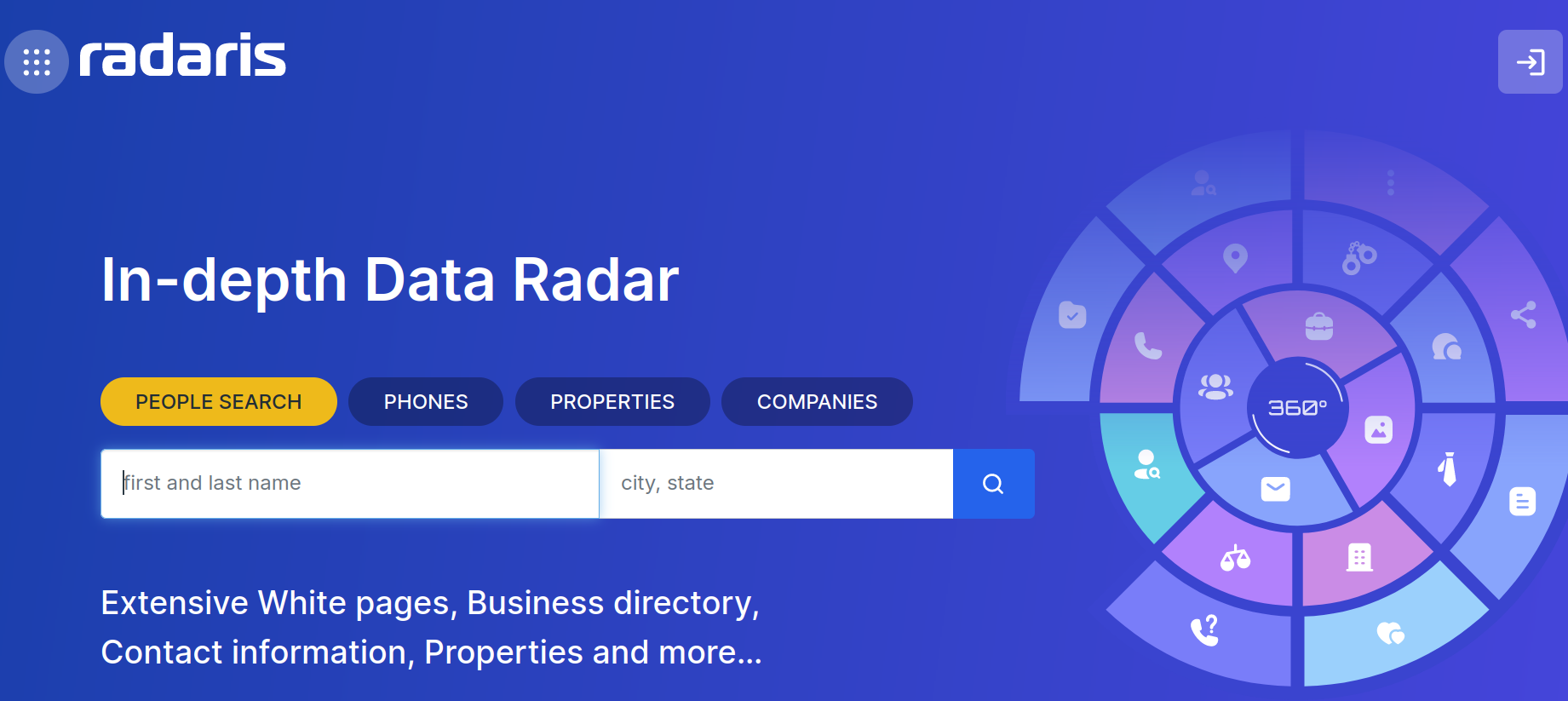
Radaris is just one cog in a sprawling network of people-search properties online that sell highly detailed background reports on U.S. consumers and businesses. Those reports typically include the subject’s current and previous addresses, partial Social Security numbers, any known licenses, email addresses and phone numbers, as well as the same information for any of their immediate relatives.
Radaris has a less-than-stellar reputation when it comes to responding to consumers seeking to have their reports removed from its various people-search services. That poor reputation, combined with indications that the true founders of Radaris have gone to extraordinary lengths to conceal their stewardship of the company, was what prompted KrebsOnSecurity to investigate the origins of Radaris in the first place.
On April 18, KrebsOnSecurity received a certified letter (PDF) from Valentin “Val” Gurvits, an attorney with the Boston Law Group, stating that KrebsOnSecurity would face a withering defamation lawsuit unless the Radaris story was immediately retracted and an apology issued to the two brothers named in the story as co-founders.
That March story worked backwards from the email address used to register radaris.com, and charted an impressive array of data broker companies created over the past 15 years by Massachusetts residents Dmitry and Igor Lubarsky (also sometimes spelled Lybarsky or Lubarski). Dmitry goes by “Dan,” and Igor uses the name “Gary.”
Those businesses included numerous websites marketed to Russian-speaking people who are new to the United States, such as russianamerica.com, newyork.ru, russiancleveland.com, russianla.com, russianmiami.com, etc. Other domains connected to the Lubarskys included Russian-language dating and adult websites, as well as affiliate programs for their international calling card businesses.
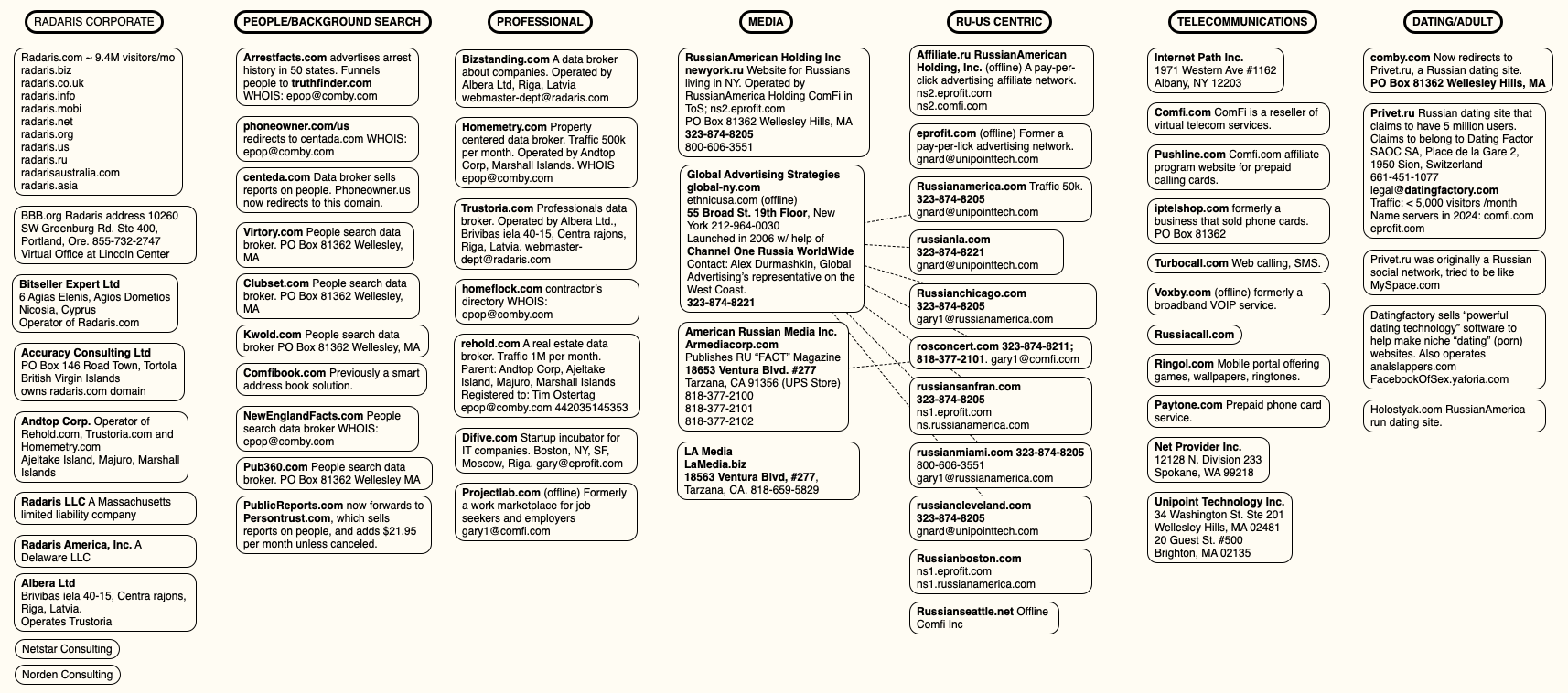
A mind map of various entities apparently tied to Radaris and the company’s co-founders. Click to enlarge.
The story on Radaris noted that the Lubarsky brothers registered most of their businesses using a made-up name — “Gary Norden,” sometimes called Gary Nord or Gary Nard.
Mr. Gurvits’ letter stated emphatically that my reporting was lazy, mean-spirited, and obviously intended to smear the reputation of his clients. By way of example, Mr. Gurvits said the Lubarskys were actually Ukrainian, and that the story painted his clients in a negative light by insinuating that they were somehow associated with Radaris and with vaguely nefarious elements in Russia.
But more to the point, Mr. Gurvits said, neither of his clients were Gary Norden, and neither had ever held any leadership positions at Radaris, nor were they financial beneficiaries of the company in any way.
“Neither of my clients is a founder of Radaris, and neither of my clients is the CEOs of Radaris,” Gurvits wrote. “Additionally, presently and going back at least the past 10 years, neither of my clients are (or were) officers or employees of Radaris. Indeed, neither of them even owns (or ever owned) any equity in Radaris. In intentional disregard of these facts, the Article implies that my clients are personally responsible for Radaris’ actions. Therefore, you intentionally caused all negative allegations in the Article made with respect to Radaris to be imputed against my clients personally.”

Dan Lubarsky’s Facebook page, just prior to the March 8 story about Radaris, said he was from Moscow.
We took Mr. Gurvits’ word on the ethnicity of his clients, and adjusted the story to remove a single mention that they were Russian. We did so even though Dan Lubarsky’s own Facebook page said (until recently) that he was from Moscow, Russia.
KrebsOnSecurity asked Mr. Gurvits to explain precisely which other details in the story were incorrect, and replied that we would be happy to update the story with a correction if they could demonstrate any errors of fact or omission.
We also requested specifics about several aspects of the story, such as the identity of the current Radaris CEO — listed on the Radaris website as “Victor K.” Mr. Gurvits replied that Radaris is and always has been based in Ukraine, and that the company’s true founder “Eugene L” is based there.
While Radaris has claimed to have offices in Massachusetts, Cyprus and Latvia, its website has never mentioned Ukraine. Mr. Gurvits has not responded to requests for more information about the identities of “Eugene L” or “Victor K.”
Gurvits said he had no intention of doing anyone’s reporting for them, and that the Lubarskys were going to sue KrebsOnSecurity for defamation unless the story was retracted in full. KrebsOnSecurity replied that journalists often face challenges to things that they report, but it is more than rare for one who makes a challenge to take umbrage at being asked for supporting information.
On June 13, Mr. Gurvits sent another letter (PDF) that continued to claim KrebsOnSecurity was defaming his clients, only this time Gurvits said his clients would be satisfied if KrebsOnSecurity just removed their names from the story.
“Ultimately, my clients don’t care what you say about any of the websites or corporate entities in your Article, as long as you completely remove my clients’ names from the Article and cooperate with my clients to have copies of the Article where my clients’ names appear removed from the Internet,” Mr. Gurvits wrote.
The June 13 letter explained that the name Gary Norden was a pseudonym invented by the Radaris marketing division, but that neither of the Lubarsky brothers were Norden.
This was a startling admission, given that Radaris has quoted the fictitious Gary Norden in press releases published and paid for by Radaris, and in news media stories where the company is explicitly seeking money from investors. In other words, Radaris has been misrepresenting itself to investors from the beginning. Here’s a press release from Radaris that was published on PR Newswire in April 2011:
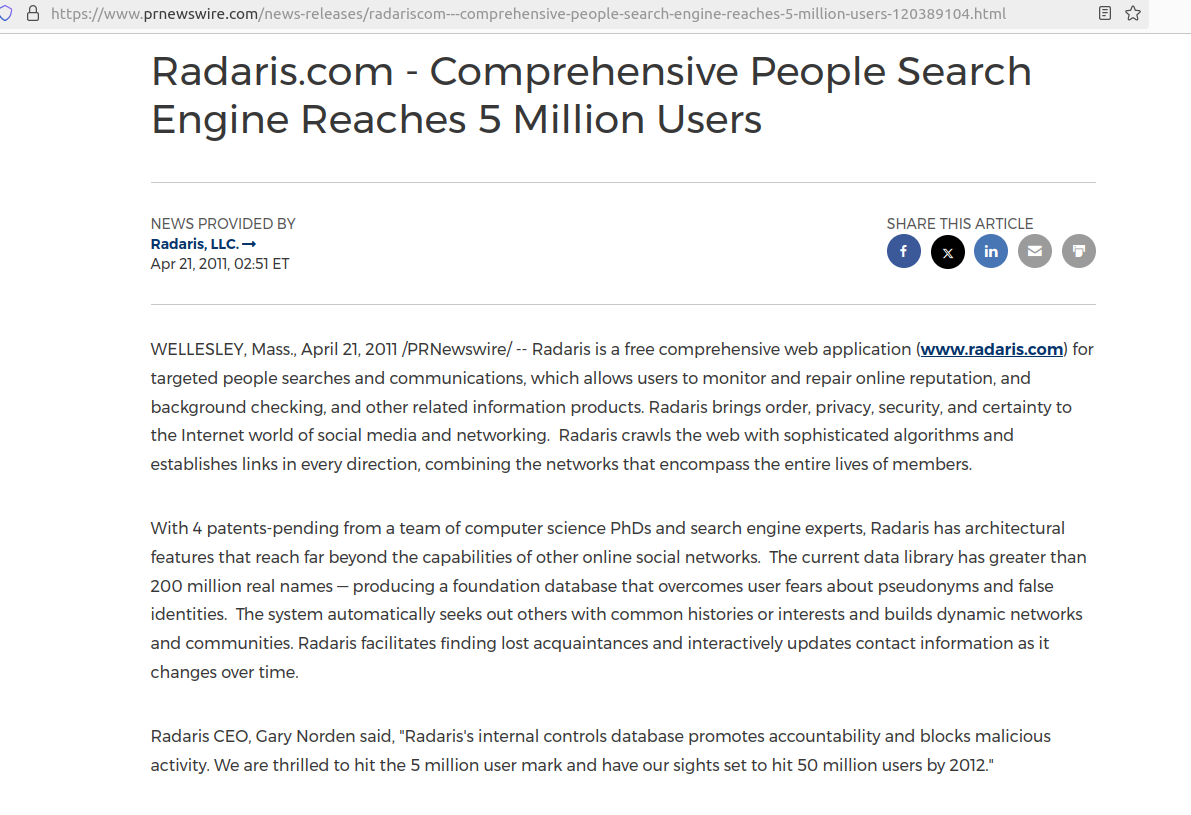
A press release published by Radaris in 2011 names the CEO of Radaris as Gary Norden, which was a fake name made up by Radaris’ marketing department.
In April 2014, the Boston Business Journal published a story (PDF) about Radaris that extolled the company’s rapid growth and considerable customer base. The story noted that, “to date, the company has raised less than $1 million from Cyprus-based investment company Difive.”
“We live in a world where information becomes much more broad and much more available every single day,” the Boston Business Journal quoted Radaris’ fake CEO Gary Norden, who by then had somehow been demoted from CEO to vice president of business development.
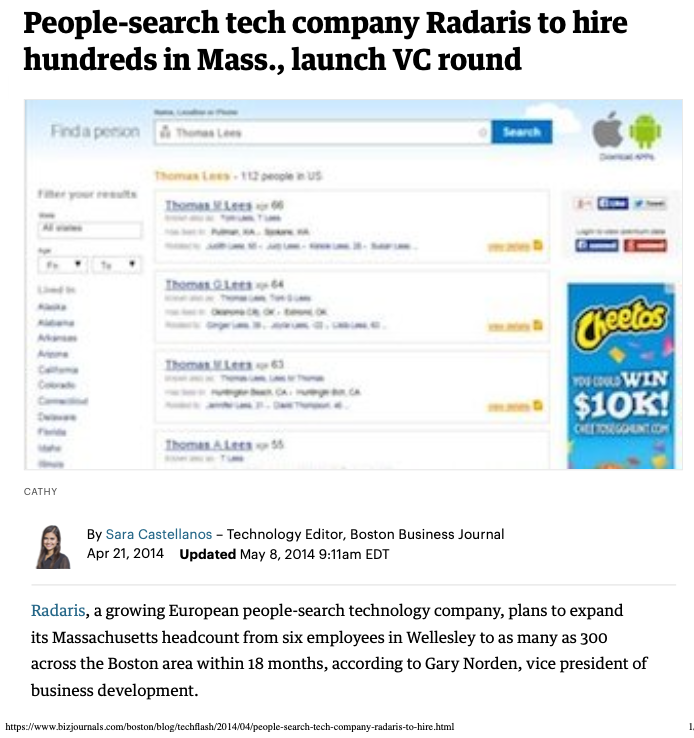
A Boston Business Journal story from April 2014 quotes the fictitious Radaris CEO Gary Norden.
“We decided there needs to be a service that allows for ease of monitoring of information about people,” the fake CEO said. The story went on to say Radaris was seeking to raise between $5 million and $7 million from investors in the ensuing months.
In his most recent demand letter, Mr. Gurvits helpfully included resumes for both of the Lubarsky brothers.
Dmitry Lubarsky’s resume states he is the owner of Difive.com, a startup incubator for IT companies. Recall that Difive is the same company mentioned by the fake Radaris CEO in the 2014 Boston Business Journal story, which said Difive was the company’s initial and sole investor.
Difive’s website in 2016 said it had offices in Boston, New York, San Francisco, Riga (Latvia) and Moscow (nothing in Ukraine). Meanwhile, DomainTools.com reports difive.com was originally registered in 2007 to the fictitious Gary Norden from Massachusetts.

Archived copies of the Difive website from 2017 include a “Portfolio” page indexing all of the companies in which Difive has invested. That list, available here, includes virtually every “Gary Norden” domain name mentioned in my original report, plus a few that escaped notice earlier.
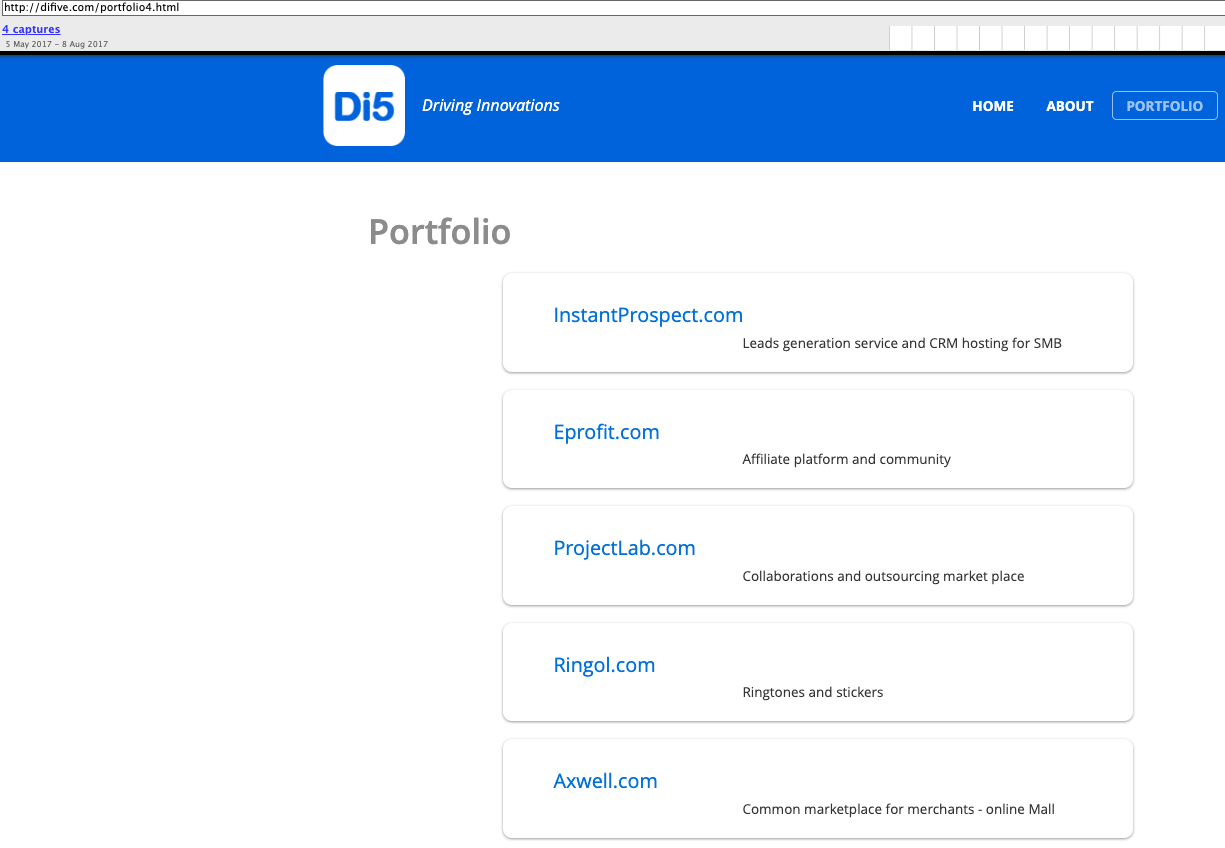
Dan Lubarsky’s resume says he was CEO of a people search company called HumanBook. The Wayback machine at archive.org shows the Humanbook domain (humanbook.com) came online around April 2008, when the company was still in “beta” mode.
By August 2008, however, humanbook.com had changed the name advertised on its homepage to Radaris Beta. Eventually, Humanbook simply redirected to radaris.com.
Astute readers may notice that the domain radaris.com is not among the companies listed as Difive investments. However, passive domain name system (DNS) records from DomainTools show that between October 2023 and March 2024 radaris.com was hosted alongside all of the other Gary Norden domains at the Internet address range 38.111.228.x.
That address range simultaneously hosted every domain mentioned in this story and in the original March 2024 report as connected to email addresses used by Gary Norden, including radaris.com, radaris.ru, radaris.de, difive.com, privet.ru, blog.ru, comfi.com, phoneowner.com, russianamerica.com, eprofit.com, rehold.com, homeflock.com, humanbook.com and dozens more. A spreadsheet of those historical DNS entries for radaris.com is available here (.csv).
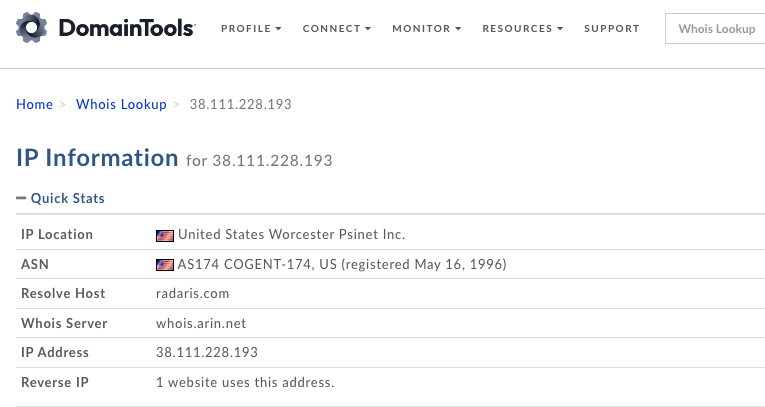
Image: DomainTools.com
The breach tracking service Constella Intelligence finds just two email addresses ending in difive.com have been exposed in data breaches over the years: dan@difive.com, and gn@difive.com. Presumably, “gn” stands for Gary Norden.
A search on the email address gn@difive.com via the breach tracking service osint.industries reveals this address was used to create an account at Airbnb under the name Gary, with the last four digits of the account’s phone number ending in “0001.”
Constella Intelligence finds gn@difive.com was associated with the Massachusetts number 617-794-0001, which was used to register accounts for “Igor Lybarsky” from Wellesley or Sherborn, Ma. at multiple online businesses, including audiusa.com and the designer eyewear store luxottica.com.
The phone number 617-794-0001 also appears for a “Gary Nard” user at russianamerica.com. Igor Lubarsky’s resume says he was the manager of russianamerica.com.
DomainTools finds 617-794-0001 is connected to registration records for three domains, including paytone.com, a domain that Dan Lubarsky’s resume says he managed. DomainTools also found that number on the registration records for trustoria.com, another major consumer data broker that has an atrocious reputation, according to the Better Business Bureau.
Dan Lubarsky’s resume says he was responsible for several international telecommunications services, including the website comfi.com. DomainTools says the phone number connected to that domain — 617-952-4234 — was also used on the registration records for humanbook.net/biz/info/mobi/us, as well as for radaris.me, radaris.in, and radaris.tel.
Two other key domains are connected to that phone number. The first is barsky.com, which is the website for Barsky Estate Realty Trust (PDF), a real estate holding company controlled by the Lubarskys. Naturally, DomainTools finds barsky.com also was registered to a Gary Norden from Massachusetts. But the organization listed in the barsky.com registration records is Comfi Inc., a VOIP communications firm that Dan Lubarsky’s resume says he managed.
The other domain of note is unipointtechnologies.com. Dan Lubarsky’s resume says he was the CEO of Wellesley Hills, Mass-based Unipoint Technology Inc. In 2012, Unipoint was fined $179,000 by the U.S. Federal Communications Commission, which said the company had failed to apply for a license to provide international telecommunications services.
A pandemic assistance loan granted in 2020 to Igor Lybarsky of Sherborn, Ma. shows he received the money to an entity called Norden Consulting.
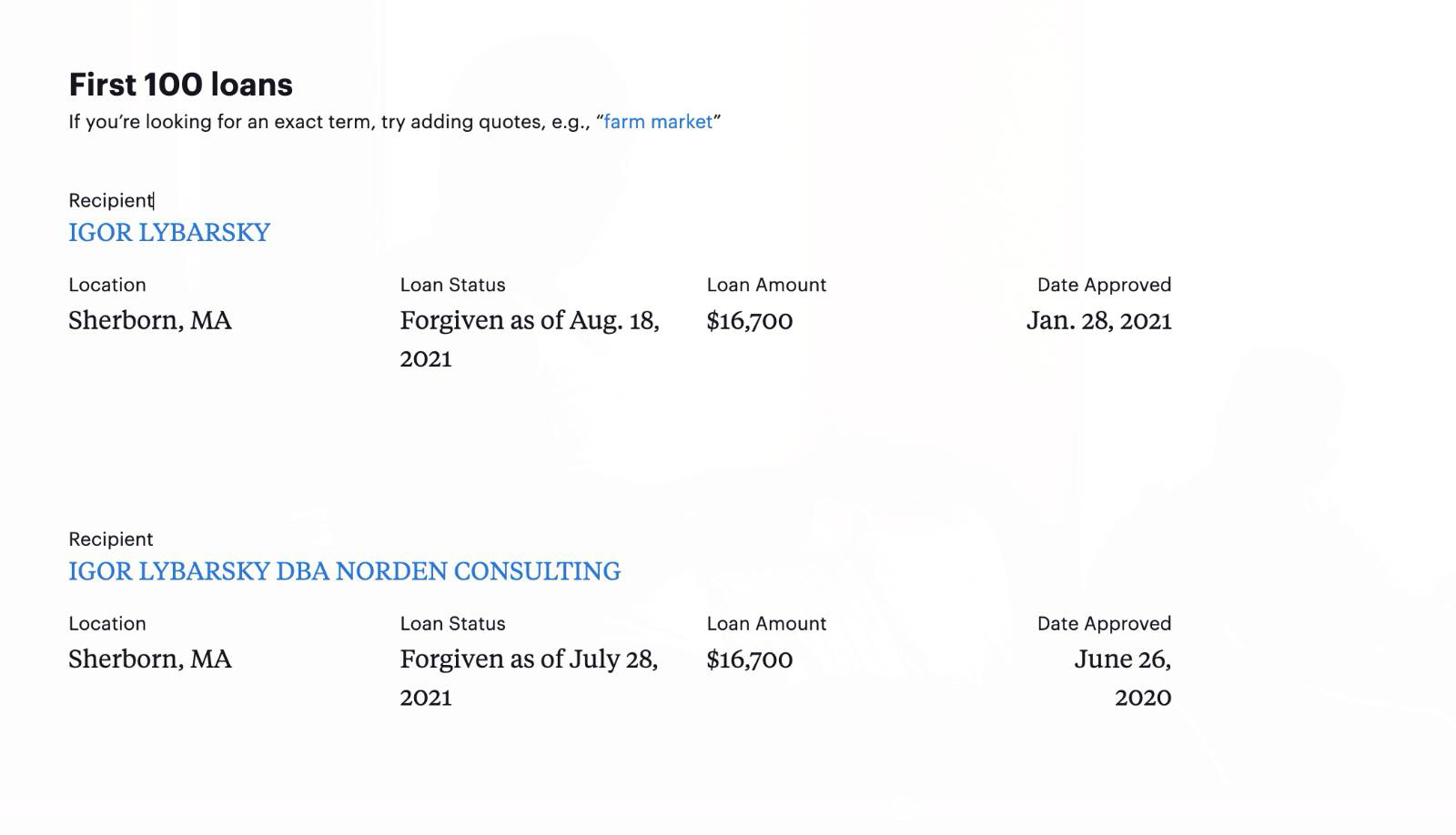
Notice the name on the recipient of this government loan for Igor Lybarsky from Sherborn, Ma: Norden Consulting.
The 2011 Radaris press release quoting their fake CEO Gary Norden said the company had four patents pending from a team of computer science PhDs. According to the resume shared by Mr. Gurvits, Dan Lubarsky has a PhD in computer science.
The U.S. Patent and Trademark Office (PTO) says Dan Lubarsky/Lubarski has at least nine technology patents to his name. The fake CEO press release from Radaris mentioning its four patents was published in April 2011. By that time, the PTO says Dan Lubarsky had applied for exactly four patents, including, “System and Method for a Web-Based People Directory.” The first of those patents, published in 2009, is tied to Humanbook.com, the company Dan Lubarsky founded that later changed its name to Radaris.
If the Lubarskys were never involved in Radaris, how do they or their attorney know the inside information that Gary Norden is a fiction of Radaris’ marketing department? KrebsOnSecurity has learned that Mr. Gurvits is the same attorney responding on behalf of Radaris in a lawsuit against the data broker filed earlier this year by Atlas Data Privacy.
Mr. Gurvits also stepped forward as Radaris’ attorney in a class action lawsuit the company lost in 2017 because it never contested the claim in court. When the plaintiffs told the judge they couldn’t collect on the $7.5 million default judgment, the judge ordered the domain registry Verisign to transfer the radaris.com domain name to the plaintiffs.
Mr. Gurvits appealed the verdict, arguing that the lawsuit hadn’t named the actual owners of the Radaris domain name — a Cyprus company called Bitseller Expert Limited — and thus taking the domain away would be a violation of their due process rights.
The judge ruled in Radaris’ favor — halting the domain transfer — and told the plaintiffs they could refile their complaint. Soon after, the operator of Radaris changed from Bitseller to Andtop Company, an entity formed (PDF) in the Marshall Islands in Oct. 2020. Andtop also operates the aforementioned people-search service Trustoria.
Mr. Gurvits’ most-publicized defamation case was a client named Aleksej Gubarev, a Russian technology executive whose name appeared in the Steele Dossier. That document included a collection of salacious, unverified information gathered by the former British intelligence officer Christopher Steele during the 2016 U.S. presidential campaign at the direction of former president Donald Trump’s political rivals.
Gubarev, the head of the IT services company XBT Holding and the Florida web hosting firm Webzilla, sued BuzzFeed for publishing the Steele dossier. One of the items in the dossier alleged that XBT/Webzilla and affiliated companies played a key role in the hack of Democratic Party computers in the spring of 2016. The memo alleged Gubarev had been coerced into providing services to Russia’s main domestic security agency, known as the FSB.
In December 2018, a federal judge in Miami ruled in favor of BuzzFeed, saying the publication was protected by the fair report privilege, which gives news organizations latitude in reporting on official government proceedings.
Radaris was originally operated by Bitseller Expert Limited. Who owns Bitseller Expert Limited? A report (PDF) obtained from the Cyprus business registry shows this company lists its director as Pavel Kaydash from Moscow. Mr. Kaydash could not be reached for comment.
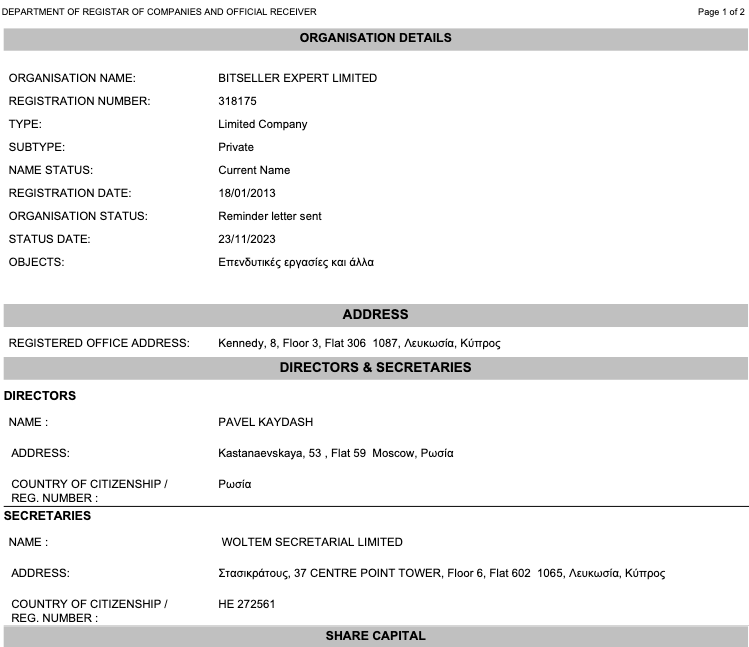
A 22-year-old man from the United Kingdom arrested this week in Spain is allegedly the ringleader of Scattered Spider, a cybercrime group suspected of hacking into Twilio, LastPass, DoorDash, Mailchimp, and nearly 130 other organizations over the past two years.
The Spanish daily Murcia Today reports the suspect was wanted by the FBI and arrested in Palma de Mallorca as he tried to board a flight to Italy.

A still frame from a video released by the Spanish national police shows Tylerb in custody at the airport.
“He stands accused of hacking into corporate accounts and stealing critical information, which allegedly enabled the group to access multi-million-dollar funds,” Murcia Today wrote. “According to Palma police, at one point he controlled Bitcoins worth $27 million.”
The cybercrime-focused Twitter/X account vx-underground said the U.K. man arrested was a SIM-swapper who went by the alias “Tyler.” In a SIM-swapping attack, crooks transfer the target’s phone number to a device they control and intercept any text messages or phone calls sent to the victim — including one-time passcodes for authentication, or password reset links sent via SMS.
“He is a known SIM-swapper and is allegedly involved with the infamous Scattered Spider group,” vx-underground wrote on June 15, referring to a prolific gang implicated in costly data ransom attacks at MGM and Caesars casinos in Las Vegas last year.
Sources familiar with the investigation told KrebsOnSecurity the accused is a 22-year-old from Dundee, Scotland named Tyler Buchanan, also allegedly known as “tylerb” on Telegram chat channels centered around SIM-swapping.
In January 2024, U.S. authorities arrested another alleged Scattered Spider member — 19-year-old Noah Michael Urban of Palm Coast, Fla. — and charged him with stealing at least $800,000 from five victims between August 2022 and March 2023. Urban allegedly went by the nicknames “Sosa” and “King Bob,” and is believed to be part of the same crew that hacked Twilio and a slew of other companies in 2022.
Investigators say Scattered Spider members are part of a more diffuse cybercriminal community online known as “The Com,” wherein hackers from different cliques boast loudly about high-profile cyber thefts that almost invariably begin with social engineering — tricking people over the phone, email or SMS into giving away credentials that allow remote access to corporate internal networks.
One of the more popular SIM-swapping channels on Telegram maintains a frequently updated leaderboard of the most accomplished SIM-swappers, indexed by their supposed conquests in stealing cryptocurrency. That leaderboard currently lists Sosa as #24 (out of 100), and Tylerb at #65.
In August 2022, KrebsOnSecurity wrote about peering inside the data harvested in a months-long cybercrime campaign by Scattered Spider involving countless SMS-based phishing attacks against employees at major corporations. The security firm Group-IB called the gang by a different name — 0ktapus, a nod to how the criminal group phished employees for credentials.
The missives asked users to click a link and log in at a phishing page that mimicked their employer’s Okta authentication page. Those who submitted credentials were then prompted to provide the one-time password needed for multi-factor authentication.
These phishing attacks used newly-registered domains that often included the name of the targeted company, and sent text messages urging employees to click on links to these domains to view information about a pending change in their work schedule. The phishing sites also featured a hidden Telegram instant message bot to forward any submitted credentials in real-time, allowing the attackers to use the phished username, password and one-time code to log in as that employee at the real employer website.
One of Scattered Spider’s first big victims in its 2022 SMS phishing spree was Twilio, a company that provides services for making and receiving text messages and phone calls. The group then pivoted, using their access to Twilio to attack at least 163 of its customers.
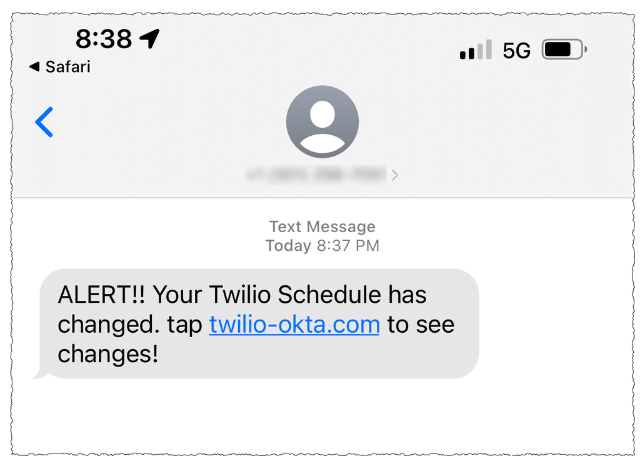
A Scattered Spider phishing lure sent to Twilio employees.
Among those was the encrypted messaging app Signal, which said the breach could have let attackers re-register the phone number on another device for about 1,900 users.
Also in August 2022, several employees at email delivery firm Mailchimp provided their remote access credentials to this phishing group. According to Mailchimp, the attackers used their access to Mailchimp employee accounts to steal data from 214 customers involved in cryptocurrency and finance.
On August 25, 2022, the password manager service LastPass disclosed a breach in which attackers stole some source code and proprietary LastPass technical information, and weeks later LastPass said an investigation revealed no customer data or password vaults were accessed.
However, on November 30, 2022 LastPass disclosed a far more serious breach that the company said leveraged data stolen in the August breach. LastPass said criminal hackers had stolen encrypted copies of some password vaults, as well as other personal information.
In February 2023, LastPass disclosed that the intrusion involved a highly complex, targeted attack against an engineer who was one of only four LastPass employees with access to the corporate vault. In that incident, the attackers exploited a security vulnerability in a Plex media server that the employee was running on his home network, and succeeded in installing malicious software that stole passwords and other authentication credentials. The vulnerability exploited by the intruders was patched back in 2020, but the employee never updated his Plex software.
Plex announced its own data breach one day before LastPass disclosed its initial August intrusion. On August 24, 2022, Plex’s security team urged users to reset their passwords, saying an intruder had accessed customer emails, usernames and encrypted passwords.
Sosa and Tylerb were both subjected to physical attacks from rival SIM-swapping gangs. These communities have been known to settle scores by turning to so-called “violence-as-a-service” offerings on cybercrime channels, wherein people can be hired to perform a variety geographically-specific “in real life” jobs, such as bricking windows, slashing car tires, or even home invasions.
In 2022, a video surfaced on a popular cybercrime channel purporting to show attackers hurling a brick through a window at an address that matches the spacious and upscale home of Urban’s parents in Sanford, Fl.
January’s story on Sosa noted that a junior member of his crew named “Foreshadow” was kidnapped, beaten and held for ransom in September 2022. Foreshadow’s captors held guns to his bloodied head while forcing him to record a video message pleading with his crew to fork over a $200,000 ransom in exchange for his life (Foreshadow escaped further harm in that incident).
According to several SIM-swapping channels on Telegram where Tylerb was known to frequent, rival SIM-swappers hired thugs to invade his home in February 2023. Those accounts state that the intruders assaulted Tylerb’s mother in the home invasion, and that they threatened to burn him with a blowtorch if he didn’t give up the keys to his cryptocurrency wallets. Tylerb was reputed to have fled the United Kingdom after that assault.
KrebsOnSecurity sought comment from Mr. Buchanan, and will update this story in the event he responds.
Microsoft today released updates to fix more than 50 security vulnerabilities in Windows and related software, a relatively light Patch Tuesday this month for Windows users. The software giant also responded to a torrent of negative feedback on a new feature of Redmond’s flagship operating system that constantly takes screenshots of whatever users are doing on their computers, saying the feature would no longer be enabled by default.

Last month, Microsoft debuted Copilot+ PCs, an AI-enabled version of Windows. Copilot+ ships with a feature nobody asked for that Redmond has aptly dubbed Recall, which constantly takes screenshots of what the user is doing on their PC. Security experts roundly trashed Recall as a fancy keylogger, noting that it would be a gold mine of information for attackers if the user’s PC was compromised with malware.
Microsoft countered that Recall snapshots never leave the user’s system, and that even if attackers managed to hack a Copilot+ PC they would not be able to exfiltrate on-device Recall data. But that claim rang hollow after former Microsoft threat analyst Kevin Beaumont detailed on his blog how any user on the system (even a non-administrator) can export Recall data, which is just stored in an SQLite database locally.
“I’m not being hyperbolic when I say this is the dumbest cybersecurity move in a decade,” Beaumont said on Mastodon.
In a recent Risky Business podcast, host Patrick Gray noted that the screenshots created and indexed by Recall would be a boon to any attacker who suddenly finds himself in an unfamiliar environment.
“The first thing you want to do when you get on a machine if you’re up to no good is to figure out how someone did their job,” Gray said. “We saw that in the case of the SWIFT attacks against central banks years ago. Attackers had to do screen recordings to figure out how transfers work. And this could speed up that sort of discovery process.”
Responding to the withering criticism of Recall, Microsoft said last week that it will no longer be enabled by default on Copilot+ PCs.
Only one of the patches released today — CVE-2024-30080 — earned Microsoft’s most urgent “critical” rating, meaning malware or malcontents could exploit the vulnerability to remotely seize control over a user’s system, without any user interaction.
CVE-2024-30080 is a flaw in the Microsoft Message Queuing (MSMQ) service that can allow attackers to execute code of their choosing. Microsoft says exploitation of this weakness is likely, enough to encourage users to disable the vulnerable component if updating isn’t possible in the short run. CVE-2024-30080 has been assigned a CVSS vulnerability score of 9.8 (10 is the worst).
Kevin Breen, senior director of threat research at Immersive Labs, said a saving grace is that MSMQ is not a default service on Windows.
“A Shodan search for MSMQ reveals there are a few thousand potentially internet-facing MSSQ servers that could be vulnerable to zero-day attacks if not patched quickly,” Breen said.
CVE-2024-30078 is a remote code execution weakness in the Windows WiFi Driver, which also has a CVSS score of 9.8. According to Microsoft, an unauthenticated attacker could exploit this bug by sending a malicious data packet to anyone else on the same network — meaning this flaw assumes the attacker has access to the local network.
Microsoft also fixed a number of serious security issues with its Office applications, including at least two remote-code execution flaws, said Adam Barnett, lead software engineer at Rapid7.
“CVE-2024-30101 is a vulnerability in Outlook; although the Preview Pane is a vector, the user must subsequently perform unspecified specific actions to trigger the vulnerability and the attacker must win a race condition,” Barnett said. “CVE-2024-30104 does not have the Preview Pane as a vector, but nevertheless ends up with a slightly higher CVSS base score of 7.8, since exploitation relies solely on the user opening a malicious file.”
Separately, Adobe released security updates for Acrobat, ColdFusion, and Photoshop, among others.
As usual, the SANS Internet Storm Center has the skinny on the individual patches released today, indexed by severity, exploitability and urgency. Windows admins should also keep an eye on AskWoody.com, which often publishes early reports of any Windows patches gone awry.
Law enforcement agencies in the United States and Europe today announced Operation Endgame, a coordinated action against some of the most popular cybercrime platforms for delivering ransomware and data-stealing malware. Dubbed “the largest ever operation against botnets,” the international effort is being billed as the opening salvo in an ongoing campaign targeting advanced malware “droppers” or “loaders” like IcedID, Smokeloader and Trickbot.

A frame from one of three animated videos released today in connection with Operation Endgame.
Operation Endgame targets the cybercrime ecosystem supporting droppers/loaders, slang terms used to describe tiny, custom-made programs designed to surreptitiously install malware onto a target system. Droppers are typically used in the initial stages of a breach, and they allow cybercriminals to bypass security measures and deploy additional harmful programs, including viruses, ransomware, or spyware.
Droppers like IcedID are most often deployed through email attachments, hacked websites, or bundled with legitimate software. For example, cybercriminals have long used paid ads on Google to trick people into installing malware disguised as popular free software, such as Microsoft Teams, Adobe Reader and Discord. In those cases, the dropper is the hidden component bundled with the legitimate software that quietly loads malware onto the user’s system.
Droppers remain such a critical, human-intensive component of nearly all major cybercrime enterprises that the most popular have turned into full-fledged cybercrime services of their own. By targeting the individuals who develop and maintain dropper services and their supporting infrastructure, authorities are hoping to disrupt multiple cybercriminal operations simultaneously.
According to a statement from the European police agency Europol, between May 27 and May 29, 2024 authorities arrested four suspects (one in Armenia and three in Ukraine), and disrupted or took down more than 100 Internet servers in Bulgaria, Canada, Germany, Lithuania, the Netherlands, Romania, Switzerland, the United Kingdom, United States and Ukraine. Authorities say they also seized more than 2,000 domain names that supported dropper infrastructure online.
In addition, Europol released information on eight fugitives suspected of involvement in dropper services and who are wanted by Germany; their names and photos were added to Europol’s “Most Wanted” list on 30 May 2024.
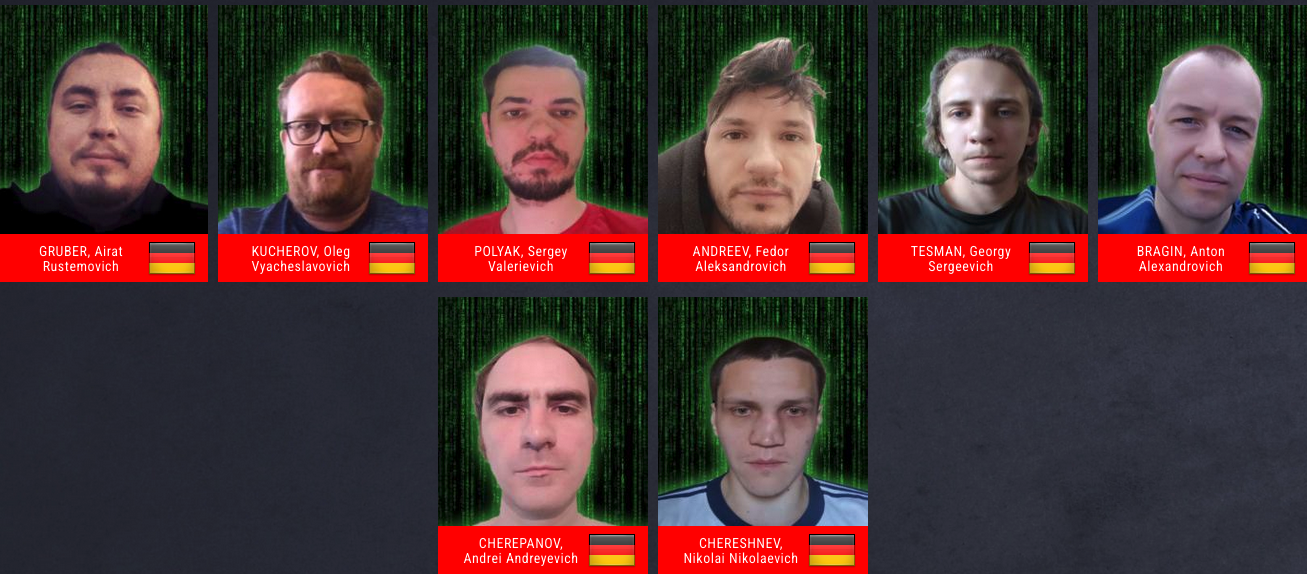
A “wanted” poster including the names and photos of eight suspects wanted by Germany and now on Europol’s “Most Wanted” list.
“It has been discovered through the investigations so far that one of the main suspects has earned at least EUR 69 million in cryptocurrency by renting out criminal infrastructure sites to deploy ransomware,” Europol wrote. “The suspect’s transactions are constantly being monitored and legal permission to seize these assets upon future actions has already been obtained.”
There have been numerous such coordinated malware takedown efforts in the past, and yet often the substantial amount of coordination required between law enforcement agencies and cybersecurity firms involved is not sustained after the initial disruption and/or arrests.
But a new website erected to detail today’s action — operation-endgame.com — makes the case that this time is different, and that more takedowns and arrests are coming. “Operation Endgame does not end today,” the site promises. “New actions will be announced on this website.”

A message on operation-endgame.com promises more law enforcement and disruption actions.
Perhaps in recognition that many of today’s top cybercriminals reside in countries that are effectively beyond the reach of international law enforcement, actions like Operation Endgame seem increasingly focused on mind games — i.e., trolling the hackers.
Writing in this month’s issue of Wired, Matt Burgess makes the case that Western law enforcement officials have turned to psychological measures as an added way to slow down Russian hackers and cut to the heart of the sweeping cybercrime ecosystem.
“These nascent psyops include efforts to erode the limited trust the criminals have in each other, driving subtle wedges between fragile hacker egos, and sending offenders personalized messages showing they’re being watched,” Burgess wrote.
When authorities in the U.S. and U.K. announced in February 2024 that they’d infiltrated and seized the infrastructure used by the infamous LockBit ransomware gang, they borrowed the existing design of LockBit’s victim shaming website to link instead to press releases about the takedown, and included a countdown timer that was eventually replaced with the personal details of LockBit’s alleged leader.
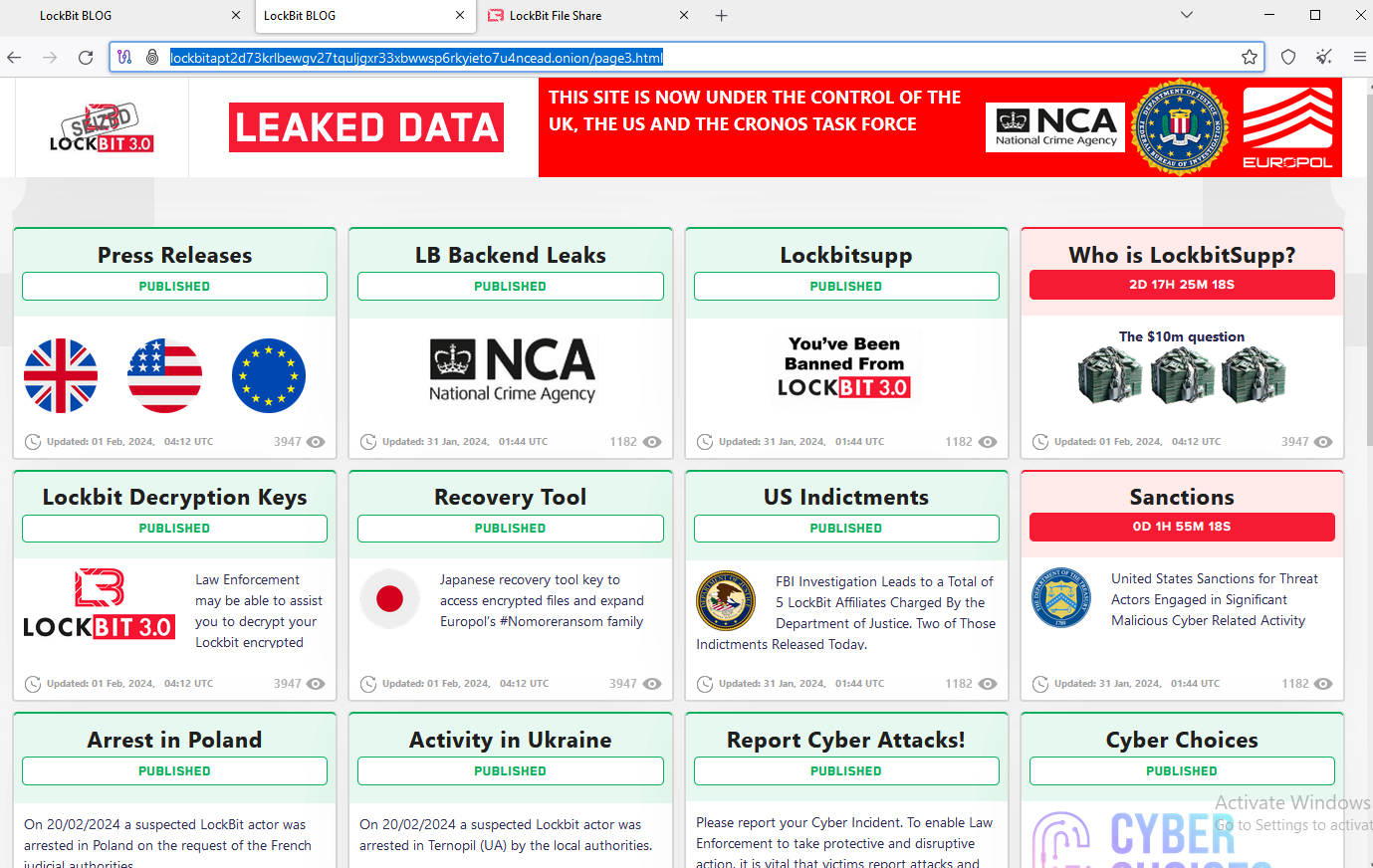
The feds used the existing design on LockBit’s victim shaming website to feature press releases and free decryption tools.
The Operation Endgame website also includes a countdown timer, which serves to tease the release of several animated videos that mimic the same sort of flashy, short advertisements that established cybercriminals often produce to promote their services online. At least two of the videos include a substantial amount of text written in Russian.
The coordinated takedown comes on the heels of another law enforcement action this week against what the director of the FBI called “likely the world’s largest botnet ever.” On Wednesday U.S. Department of Justice (DOJ) announced the arrest of YunHe Wang, the alleged operator of the ten-year-old online anonymity service 911 S5. The government also seized 911 S5’s domains and online infrastructure, which allegedly turned computers running various “free VPN” products into Internet traffic relays that facilitated billions of dollars in online fraud and cybercrime.

The homepage of Stark Industries Solutions.
Two weeks before Russia invaded Ukraine in February 2022, a large, mysterious new Internet hosting firm called Stark Industries Solutions materialized and quickly became the epicenter of massive distributed denial-of-service (DDoS) attacks on government and commercial targets in Ukraine and Europe. An investigation into Stark Industries reveals it is being used as a global proxy network that conceals the true source of cyberattacks and disinformation campaigns against enemies of Russia.
At least a dozen patriotic Russian hacking groups have been launching DDoS attacks since the start of the war at a variety of targets seen as opposed to Moscow. But by all accounts, few attacks from those gangs have come close to the amount of firepower wielded by a pro-Russia group calling itself “NoName057(16).”
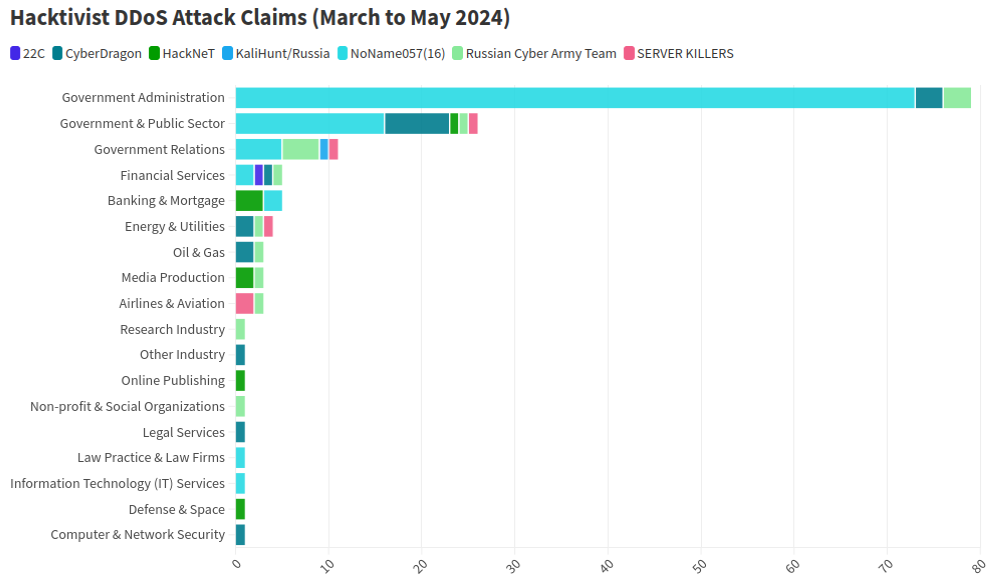
This graphic comes from a recent report from NETSCOUT about DDoS attacks from Russian hacktivist groups.
As detailed by researchers at Radware, NoName has effectively gamified DDoS attacks, recruiting hacktivists via its Telegram channel and offering to pay people who agree to install a piece of software called DDoSia. That program allows NoName to commandeer the host computers and their Internet connections in coordinated DDoS campaigns, and DDoSia users with the most attacks can win cash prizes.

The NoName DDoS group advertising on Telegram. Image: SentinelOne.com.
A report from the security firm Team Cymru found the DDoS attack infrastructure used in NoName campaigns is assigned to two interlinked hosting providers: MIRhosting and Stark Industries. MIRhosting is a hosting provider founded in The Netherlands in 2004. But Stark Industries Solutions Ltd was incorporated on February 10, 2022, just two weeks before the Russian invasion of Ukraine.
Security experts say that not long after the war started, Stark began hosting dozens of proxy services and free virtual private networking (VPN) services, which are designed to help users shield their Internet usage and location from prying eyes.
Proxy providers allow users to route their Internet and Web browsing traffic through someone else’s computer. From a website’s perspective, the traffic from a proxy network user appears to originate from the rented IP address, not from the proxy service customer.

These services can be used in a legitimate manner for several business purposes — such as price comparisons or sales intelligence — but they are also massively abused for hiding cybercrime activity because they can make it difficult to trace malicious traffic to its original source.
What’s more, many proxy services do not disclose how they obtain access to the proxies they are renting out, and in many cases the access is obtained through the dissemination of malicious software that turns the infected system into a traffic relay — usually unbeknownst to the legitimate owner of the Internet connection. Other proxy services will allow users to make money by renting out their Internet connection to anyone.
Spur.us is a company that tracks VPNs and proxy services worldwide. Spur finds that Stark Industries (AS44477) currently is home to at least 74 VPN services, and 40 different proxy services. As we’ll see in the final section of this story, just one of those proxy networks has over a million Internet addresses available for rent across the globe.
Raymond Dijkxhoorn operates a hosting firm in The Netherlands called Prolocation. He also co-runs SURBL, an anti-abuse service that flags domains and Internet address ranges that are strongly associated with spam and cybercrime activity, including DDoS.
Dijkxhoorn said last year SURBL heard from multiple people who said they operated VPN services whose web resources were included in SURBL’s block lists.
“We had people doing delistings at SURBL for domain names that were suspended by the registrars,” Dijkhoorn told KrebsOnSecurity. “And at least two of them explained that Stark offered them free VPN services that they were reselling.”
Dijkxhoorn added that Stark Industries also sponsored activist groups from Ukraine.
“How valuable would it be for Russia to know the real IPs from Ukraine’s tech warriors?” he observed.
Richard Hummel is threat intelligence lead at NETSCOUT. Hummel said when he considers the worst of all the hosting providers out there today, Stark Industries is consistently near or at the top of that list.
“The reason is we’ve had at least a dozen service providers come to us saying, ‘There’s this network out there inundating us with traffic,'” Hummel said. “And it wasn’t even DDoS attacks. [The systems] on Stark were just scanning these providers so fast it was crashing some of their services.”
Hummel said NoName will typically launch their attacks using a mix of resources rented from major, legitimate cloud services, and those from so-called “bulletproof” hosting providers like Stark. Bulletproof providers are so named when they earn or cultivate a reputation for ignoring any abuse complaints or police reports about activity on their networks.
Combining bulletproof providers with legitimate cloud hosting, Hummel said, likely makes NoName’s DDoS campaigns more resilient because many network operators will hesitate to be too aggressive in blocking Internet addresses associated with the major cloud services.
“What we typically see here is a distribution of cloud hosting providers and bulletproof hosting providers in DDoS attacks,” he said. “They’re using public cloud hosting providers because a lot of times that’s your first layer of network defense, and because [many companies are wary of] over-blocking access to legitimate cloud resources.”
But even if the cloud provider detects abuse coming from the customer, the provider is probably not going to shut the customer down immediately, Hummel said.
“There is usually a grace period, and even if that’s only an hour or two, you can still launch a large number of attacks in that time,” he said. “And then they just keep coming back and opening new cloud accounts.”
Stark Industries is incorporated at a mail drop address in the United Kingdom. UK business records list an Ivan Vladimirovich Neculiti as the company’s secretary. Mr. Neculiti also is named as the CEO and founder of PQ Hosting Plus S.R.L. (aka Perfect Quality Hosting), a Moldovan company formed in 2019 that lists the same UK mail drop address as Stark Industries.

Ivan Neculiti, as pictured on LinkedIn.
Reached via LinkedIn, Mr. Neculiti said PQ Hosting established Stark Industries as a “white label” of its brand so that “resellers could distribute our services using our IP addresses and their clients would not have any affairs with PQ Hosting.”
“PQ Hosting is a company with over 1,000+ of [our] own physical servers in 38 countries and we have over 100,000 clients,” he said. “Though we are not as large as Hetzner, Amazon and OVH, nevertheless we are a fast growing company that provides services to tens of thousands of private customers and legal entities.”
Asked about the constant stream of DDoS attacks whose origins have traced back to Stark Industries over the past two years, Neculiti maintained Stark hasn’t received any official abuse reports about attacks coming from its networks.
“It was probably some kind of clever attack that we did not see, I do not rule out this fact, because we have a very large number of clients and our Internet channels are quite large,” he said. “But, in this situation, unfortunately, no one contacted us to report that there was an attack from our addresses; if someone had contacted us, we would have definitely blocked the network data.”
DomainTools.com finds Ivan V. Neculiti was the owner of war[.]md, a website launched in 2008 that chronicled the history of a 1990 armed conflict in Moldova known as the Transnistria War and the Moldo-Russian war.

An ad for war.md, circa 2009.
Transnistria is a breakaway pro-Russian region that declared itself a state in 1990, although it is not internationally recognized. The copyright on that website credits the “MercenarieS TeaM,” which was at one time a Moldovan IT firm. Mr. Neculiti confirmed personally registering this domain.
The data breach tracking service Constella Intelligence reports that an Ivan V. Neculiti registered multiple online accounts under the email address dfyz_bk@bk.ru. Cyber intelligence firm Intel 471 shows this email address is tied to the username “dfyz” on more than a half-dozen Russian language cybercrime forums since 2008. The user dfyz on Searchengines[.]ru in 2008 asked other forum members to review war.md, and said they were part of the MercenarieS TeaM.
Back then, dfyz was selling “bulletproof servers for any purpose,” meaning the hosting company would willfully ignore abuse complaints or police inquiries about the activity of its customers.
DomainTools reports there are at least 33 domain names registered to dfyz_bk@bk.ru. Several of these domains have Ivan Neculiti in their registration records, including tracker-free[.]cn, which was registered to an Ivan Neculiti at dfyz_bk@bk.ru and referenced the MercenarieS TeaM in its original registration records.
Dfyz also used the nickname DonChicho, who likewise sold bulletproof hosting services and access to hacked Internet servers. In 2014, a prominent member of the Russian language cybercrime community Antichat filed a complaint against DonChicho, saying this user scammed them and had used the email address dfyz_bk@bk.ru.
The complaint said DonChicho registered on Antichat from the Transnistria Internet address 84.234.55[.]29. Searching this address in Constella reveals it has been used to register just five accounts online that have been created over the years, including one at ask.ru, where the user registered with the email address neculitzy1@yandex.ru. Constella also returns for that email address a user by the name “Ivan” at memoraleak.com and 000webhost.com.
Constella finds that the password most frequently used by the email address dfyz_bk@bk.ru was “filecast,” and that there are more than 90 email addresses associated with this password. Among them are roughly two dozen addresses with the name “Neculiti” in them, as well as the address support@donservers[.]ru.
Intel 471 says DonChicho posted to several Russian cybercrime forums that support@donservers[.]ru was his address, and that he logged into cybercrime forums almost exclusively from Internet addresses in Tiraspol, the capital of Transnistria. A review of DonChicho’s posts shows this person was banned from several forums in 2014 for scamming other users.
Cached copies of DonChicho’s vanity domain (donchicho[.]ru) show that in 2009 he was a spammer who peddled knockoff prescription drugs via Rx-Promotion, once one of the largest pharmacy spam moneymaking programs for Russian-speaking affiliates.
Mr. Neculiti told KrebsOnSecurity he has never used the nickname DonChicho.
“I may assure you that I have no relation to DonChicho nor to his bulletproof servers,” he said.
Below is a mind map that shows the connections between the accounts mentioned above.
Earlier this year, NoName began massively hitting government and industry websites in Moldova. A new report from Arbor Networks says the attacks began around March 6, when NoName alleged the government of Moldova was “craving for Russophobia.”
“Since early March, more than 50 websites have been targeted, according to posted ‘proof’ by the groups involved in attacking the country,” Arbor’s ASERT Team wrote. “While NoName seemingly initiated the ramp of attacks, a host of other DDoS hacktivists have joined the fray in claiming credit for attacks across more than 15 industries.”
The German independent news outlet Correctiv.org last week published a scathing investigative report on Stark Industries and MIRhosting, which notes that Ivan Neculiti operates his hosting companies with the help of his brother, Yuri.
The report points out that Stark Industries continues to host a Russian disinformation news outlet called “Recent Reliable News” (RRN) that was sanctioned by the European Union in 2023 for spreading links to propaganda blogs and fake European media and government websites.
“The website was not running on computers in Moscow or St. Petersburg until recently, but in the middle of the EU, in the Netherlands, on the computers of the Neculiti brothers,” Correctiv reporters wrote.
“After a request from this editorial team, a well-known service was installed that hides the actual web host,” the report continues. “Ivan Neculiti announced that he had blocked the associated access and server following internal investigations. “We very much regret that we are only now finding out that one of our customers is a sanctioned portal,” said the company boss. However, RRN is still accessible via its servers.”
Correctiv also points to a January 2023 report from the Ukrainian government, which found servers from Stark Industries Solutions were used as part of a cyber attack on the Ukrainian news agency “Ukrinform”. Correctiv notes the notorious hacker group Sandworm — an advanced persistent threat (APT) group operated by a cyberwarfare unit of Russia’s military intelligence service — was identified by Ukrainian government authorities as responsible for that attack.
Public records indicate MIRhosting is based in The Netherlands and is operated by 37-year old Andrey Nesterenko, whose personal website says he is an accomplished concert pianist who began performing publicly at a young age.
DomainTools says mirhosting[.]com is registered to Mr. Nesterenko and to Innovation IT Solutions Corp, which lists addresses in London and in Nesterenko’s stated hometown of Nizhny Novgorod, Russia.
This is interesting because according to the book Inside Cyber Warfare by Jeffrey Carr, Innovation IT Solutions Corp. was responsible for hosting StopGeorgia[.]ru, a hacktivist website for organizing cyberattacks against Georgia that appeared at the same time Russian forces invaded the former Soviet nation in 2008. That conflict was thought to be the first war ever fought in which a notable cyberattack and an actual military engagement happened simultaneously.
Responding to questions from KrebsOnSecurity, Mr. Nesterenko said he couldn’t say whether his network had ever hosted the StopGeorgia website back in 2008 because his company didn’t keep records going back that far. But he said Stark Industries Solutions is indeed one of MIRhsoting’s colocation customers.
“Our relationship is purely provider-customer,” Nesterenko said. “They also utilize multiple providers and data centers globally, so connecting them directly to MIRhosting overlooks their broader network.”
“We take any report of malicious activity seriously and are always open to information that can help us identify and prevent misuse of our infrastructure, whether involving Stark Industries or any other customer,” Nesterenko continued. “In cases where our services are exploited for malicious purposes, we collaborate fully with Dutch cyber police and other relevant authorities to investigate and take appropriate measures. However, we have yet to receive any actionable information beyond the article itself, which has not provided us with sufficient detail to identify or block malicious actors.”
In December 2022, security firm Recorded Future profiled the phishing and credential harvesting infrastructure used for Russia-aligned espionage operations by a group dubbed Blue Charlie (aka TAG-53), which has targeted email accounts of nongovernmental organizations and think tanks, journalists, and government and defense officials.
Recorded Future found that virtually all the Blue Charlie domains existed in just ten different ISPs, with a significant concentration located in two networks, one of which was MIRhosting. Both Microsoft and the UK government assess that Blue Charlie is linked to the Russian threat activity groups variously known as Callisto Group, COLDRIVER, and SEABORGIUM.
Mr. Nesterenko took exception to a story on that report from The Record, which is owned by Recorded Future.
“We’ve discussed its contents with our customer, Stark Industries,” he said. “We understand that they have initiated legal proceedings against the website in question, as they firmly believe that the claims made are inaccurate.”
Recorded Future said they updated their story with comments from Mr. Neculiti, but that they stand by their reporting.
Mr. Nesterenko’s LinkedIn profile says he was previously the foreign region sales manager at Serverius-as, a hosting company in The Netherlands that remains in the same data center as MIRhosting.
In February, the Dutch police took 13 servers offline that were used by the infamous LockBit ransomware group, which had originally bragged on its darknet website that its home base was in The Netherlands. Sources tell KrebsOnSecurity the servers seized by the Dutch police were located in Serverius’ data center in Dronten, which is also shared by MIRhosting.
Serverius-as did not respond to requests for comment. Nesterenko said MIRhosting does use one of Serverius’s data centers for its operations in the Netherlands, alongside two other data centers, but that the recent incident involving the seizure of servers has no connection to MIRhosting.
“We are legally prohibited by Dutch law and police regulations from sharing information with third parties regarding any communications we may have had,” he said.
A February 2024 report from security firm ESET found Serverius-as systems were involved in a series of targeted phishing attacks by Russia-aligned groups against Ukrainian entities throughout 2023. ESET observed that after the spearphishing domains were no longer active, they were converted to promoting rogue Internet pharmacy websites.
A review of the Internet address ranges recently added to the network operated by Stark Industries Solutions offers some insight into its customer base, usage, and maybe even true origins. Here is a snapshot (PDF) of all Internet address ranges announced by Stark Industries so far in the month of May 2024 (this information was graciously collated by the network observability platform Kentik.com).
Those records indicate that the largest portion of the IP space used by Stark is in The Netherlands, followed by Germany and the United States. Stark says it is connected to roughly 4,600 Internet addresses that currently list their ownership as Comcast Cable Communications.
A review of those address ranges at spur.us shows all of them are connected to an entity called Proxyline, which is a sprawling proxy service based in Russia that currently says it has more than 1.6 million proxies globally that are available for rent.
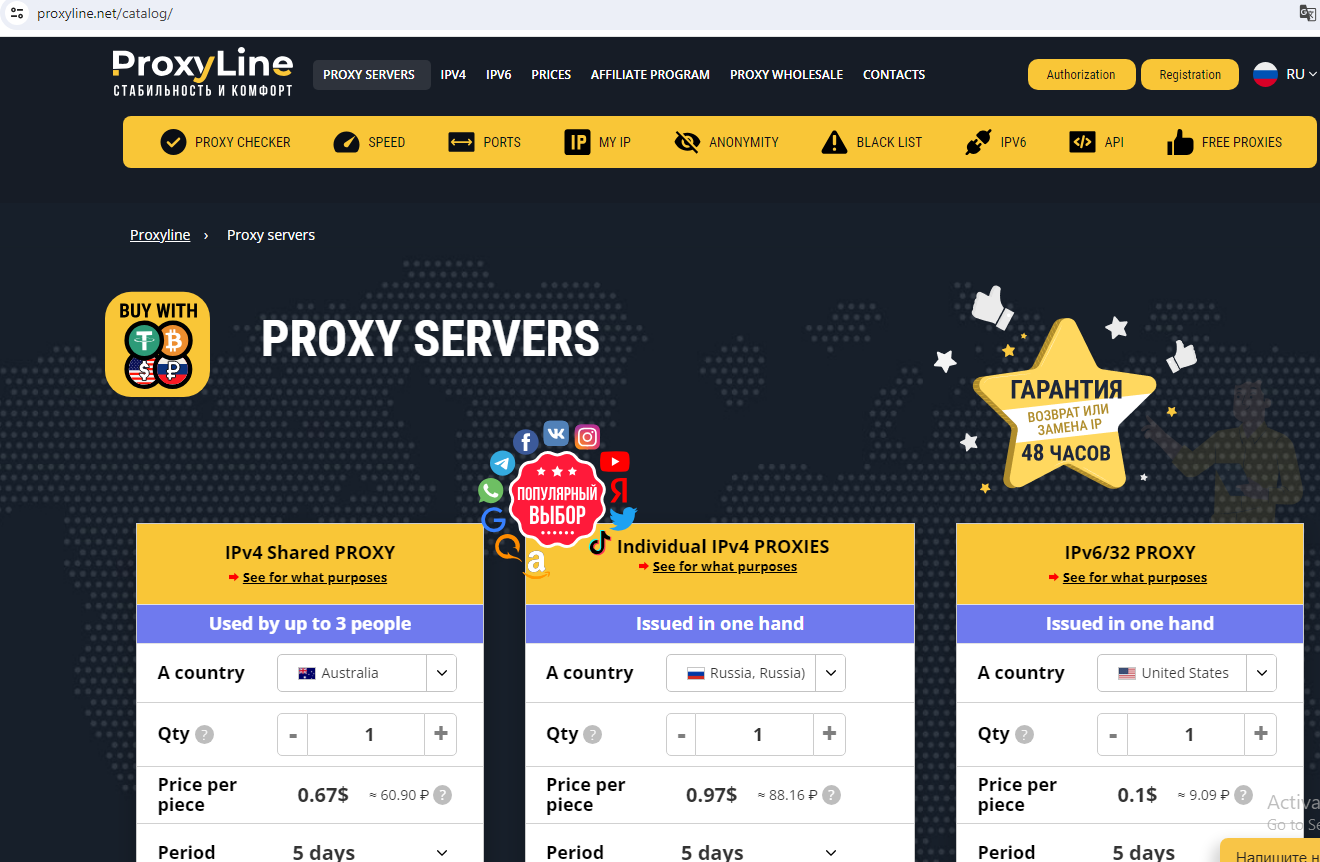
Proxyline dot net.
Reached for comment, Comcast said the Internet address ranges never did belong to Comcast, so it is likely that Stark has been fudging the real location of its routing announcements in some cases.
Stark reports that it has more than 67,000 Internet addresses at Santa Clara, Calif.-based EGIhosting. Spur says the Stark addresses involving EGIhosting all map to Proxyline as well. EGIhosting did not respond to requests for comment.
EGIhosting manages Internet addresses for the Cyprus-based hosting firm ITHOSTLINE LTD (aka HOSTLINE-LTD), which is represented throughout Stark’s announced Internet ranges. Stark says it has more than 21,000 Internet addresses with HOSTLINE. Spur.us finds Proxyline addresses are especially concentrated in the Stark ranges labeled ITHOSTLINE LTD, HOSTLINE-LTD, and Proline IT.
Stark’s network list includes approximately 21,000 Internet addresses at Hockessin, De. based DediPath, which abruptly ceased operations without warning in August 2023. According to a phishing report released last year by Interisle Consulting, DediPath was the fourth most common source of phishing attacks in the year ending Oct. 2022. Spur.us likewise finds that virtually all of the Stark address ranges marked “DediPath LLC” are tied to Proxyline.

Image: Interisle Consulting.
A large number of the Internet address ranges announced by Stark in May originate in India, and the names that are self-assigned to many of these networks indicate they were previously used to send large volumes of spam for herbal medicinal products, with names like HerbalFarm, AdsChrome, Nutravo, Herbzoot and Herbalve.
The anti-spam organization SpamHaus reports that many of the Indian IP address ranges are associated with known “snowshoe spam,” a form of abuse that involves mass email campaigns spread across several domains and IP addresses to weaken reputation metrics and avoid spam filters.
It’s not clear how much of Stark’s network address space traces its origins to Russia, but big chunks of it recently belonged to some of the oldest entities on the Russian Internet (a.k.a. “Runet”).
For example, many Stark address ranges were most recently assigned to a Russian government entity whose full name is the “Federal State Autonomous Educational Establishment of Additional Professional Education Center of Realization of State Educational Policy and Informational Technologies.”
A review of Internet address ranges adjacent to this entity reveals a long list of Russian government organizations that are part of the Federal Guard Service of the Russian Federation. Wikipedia says the Federal Guard Service is a Russian federal government agency concerned with tasks related to protection of several high-ranking state officials, including the President of Russia, as well as certain federal properties. The agency traces its origins to the USSR’s Ninth Directorate of the KGB, and later the presidential security service.
Stark recently announced the address range 213.159.64.0/20 from April 27 to May 1, and this range was previously assigned to an ancient ISP in St. Petersburg, RU called the Computer Technologies Institute Ltd.
According to a post on the Russian language webmaster forum searchengines[.]ru, the domain for Computer Technologies Institute — ctinet[.]ru — is the seventh-oldest domain in the entire history of the Runet.
Curiously, Stark also lists large tracts of Internet addresses (close to 48,000 in total) assigned to a small ISP in Kharkiv, Ukraine called NetAssist. Reached via email, the CEO of NetAssist Max Tulyev confirmed his company provides a number of services to PQ Hosting.
“We colocate their equipment in Warsaw, Madrid, Sofia and Thessaloniki, provide them IP transit and IPv4 addresses,” Tulyev said. “For their size, we receive relatively low number of complains to their networks. I never seen anything about their pro-Russian activity or support of Russian hackers. It is very interesting for me to see proofs of your accusations.”
Spur.us mapped the entire infrastructure of Proxyline, and found more than one million proxies across multiple providers, but by far the biggest concentration was at Stark Industries Solutions. The full list of Proxyline address ranges (.CSV) shows two other ISPs appear repeatedly throughout the list. One is Kharkiv, Ukraine based ITL LLC, also known as Information Technology Laboratories Group, and Integrated Technologies Laboratory.
The second is a related hosting company in Miami, called Green Floid LLC. Green Floid featured in a 2017 scoop by CNN, which profiled the company’s owner and quizzed him about Russian troll farms using proxy networks on Green Floid and its parent firm ITL to mask disinformation efforts tied to the Kremlin’s Internet Research Agency (IRA). At the time, the IRA was using Facebook and other social media networks to spread videos showing police brutality against African Americans in an effort to encourage protests across the United States.
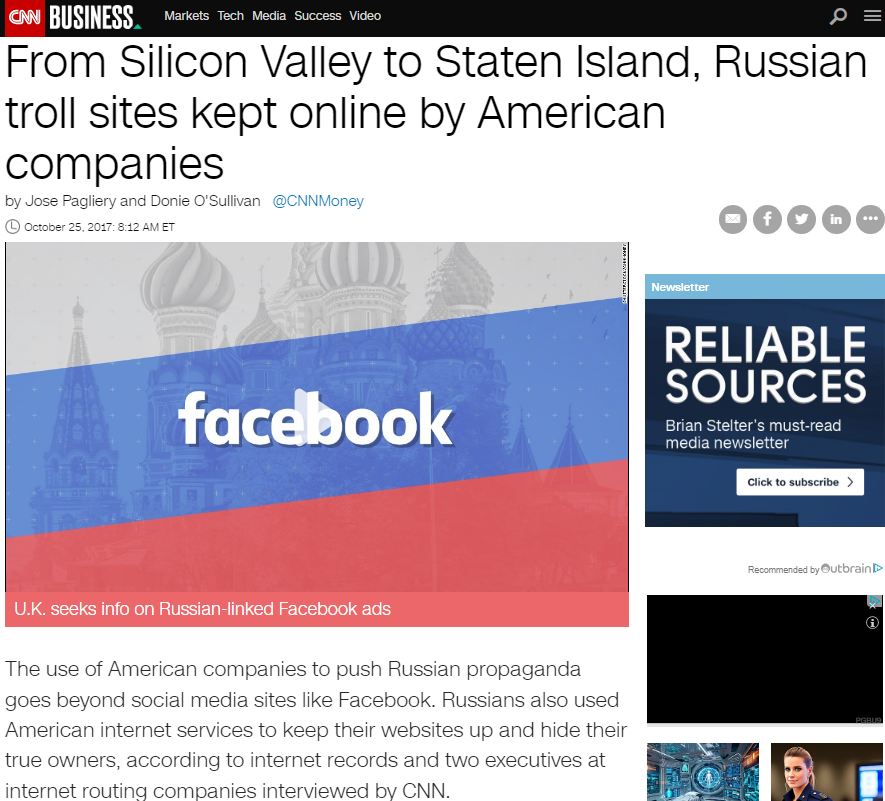
Doug Madory, director of Internet analysis at Kentik, was able to see at a high level the top sources and destinations for traffic traversing Stark’s network.
“Based on our aggregate NetFlow, we see Iran as the top destination (35.1%) for traffic emanating from Stark (AS44477),” Madory said. “Specifically, the top destination is MTN Irancell, while the top source is Facebook. This data supports the theory that AS44477 houses proxy services as Facebook is blocked in Iran.”
On April 30, the security firm Malwarebytes explored an extensive malware operation that targets corporate Internet users with malicious ads. Among the sites used as lures in that campaign were fake Wall Street Journal and CNN websites that told visitors they were required to install a WSJ or CNN-branded browser extension (malware). Malwarebytes found a domain name central to that operation was hosted at Internet addresses owned by Stark Industries.
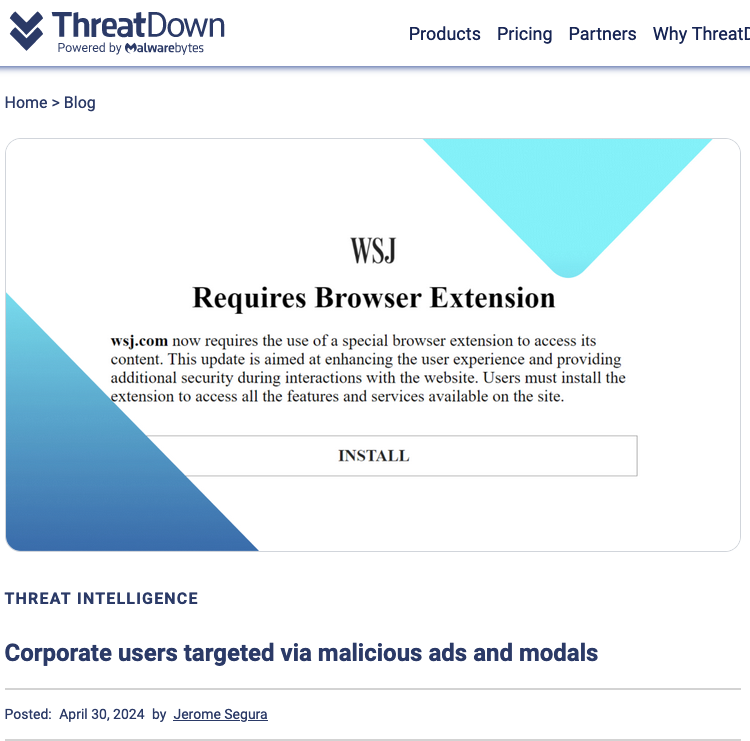
Image: threatdown.com

Image: Shutterstock.
Apple and the satellite-based broadband service Starlink each recently took steps to address new research into the potential security and privacy implications of how their services geo-locate devices. Researchers from the University of Maryland say they relied on publicly available data from Apple to track the location of billions of devices globally — including non-Apple devices like Starlink systems — and found they could use this data to monitor the destruction of Gaza, as well as the movements and in many cases identities of Russian and Ukrainian troops.
At issue is the way that Apple collects and publicly shares information about the precise location of all Wi-Fi access points seen by its devices. Apple collects this location data to give Apple devices a crowdsourced, low-power alternative to constantly requesting global positioning system (GPS) coordinates.
Both Apple and Google operate their own Wi-Fi-based Positioning Systems (WPS) that obtain certain hardware identifiers from all wireless access points that come within range of their mobile devices. Both record the Media Access Control (MAC) address that a Wi-FI access point uses, known as a Basic Service Set Identifier or BSSID.
Periodically, Apple and Google mobile devices will forward their locations — by querying GPS and/or by using cellular towers as landmarks — along with any nearby BSSIDs. This combination of data allows Apple and Google devices to figure out where they are within a few feet or meters, and it’s what allows your mobile phone to continue displaying your planned route even when the device can’t get a fix on GPS.
With Google’s WPS, a wireless device submits a list of nearby Wi-Fi access point BSSIDs and their signal strengths — via an application programming interface (API) request to Google — whose WPS responds with the device’s computed position. Google’s WPS requires at least two BSSIDs to calculate a device’s approximate position.
Apple’s WPS also accepts a list of nearby BSSIDs, but instead of computing the device’s location based off the set of observed access points and their received signal strengths and then reporting that result to the user, Apple’s API will return the geolocations of up to 400 hundred more BSSIDs that are nearby the one requested. It then uses approximately eight of those BSSIDs to work out the user’s location based on known landmarks.
In essence, Google’s WPS computes the user’s location and shares it with the device. Apple’s WPS gives its devices a large enough amount of data about the location of known access points in the area that the devices can do that estimation on their own.
That’s according to two researchers at the University of Maryland, who theorized they could use the verbosity of Apple’s API to map the movement of individual devices into and out of virtually any defined area of the world. The UMD pair said they spent a month early in their research continuously querying the API, asking it for the location of more than a billion BSSIDs generated at random.
They learned that while only about three million of those randomly generated BSSIDs were known to Apple’s Wi-Fi geolocation API, Apple also returned an additional 488 million BSSID locations already stored in its WPS from other lookups.
UMD Associate Professor David Levin and Ph.D student Erik Rye found they could mostly avoid requesting unallocated BSSIDs by consulting the list of BSSID ranges assigned to specific device manufacturers. That list is maintained by the Institute of Electrical and Electronics Engineers (IEEE), which is also sponsoring the privacy and security conference where Rye is slated to present the UMD research later today.
Plotting the locations returned by Apple’s WPS between November 2022 and November 2023, Levin and Rye saw they had a near global view of the locations tied to more than two billion Wi-Fi access points. The map showed geolocated access points in nearly every corner of the globe, apart from almost the entirety of China, vast stretches of desert wilderness in central Australia and Africa, and deep in the rainforests of South America.
The researchers said that by zeroing in on or “geofencing” other smaller regions indexed by Apple’s location API, they could monitor how Wi-Fi access points moved over time. Why might that be a big deal? They found that by geofencing active conflict zones in Ukraine, they were able to determine the location and movement of Starlink devices used by both Ukrainian and Russian forces.
The reason they were able to do that is that each Starlink terminal — the dish and associated hardware that allows a Starlink customer to receive Internet service from a constellation of orbiting Starlink satellites — includes its own Wi-Fi access point, whose location is going to be automatically indexed by any nearby Apple devices that have location services enabled.
The University of Maryland team geo-fenced various conflict zones in Ukraine, and identified at least 3,722 Starlink terminals geolocated in Ukraine.
“We find what appear to be personal devices being brought by military personnel into war zones, exposing pre-deployment sites and military positions,” the researchers wrote. “Our results also show individuals who have left Ukraine to a wide range of countries, validating public reports of where Ukrainian refugees have resettled.”
In an interview with KrebsOnSecurity, the UMD team said they found that in addition to exposing Russian troop pre-deployment sites, the location data made it easy to see where devices in contested regions originated from.
“This includes residential addresses throughout the world,” Levin said. “We even believe we can identify people who have joined the Ukraine Foreign Legion.”
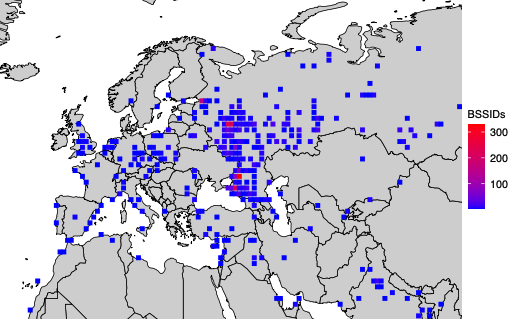
A simplified map of where BSSIDs that enter the Donbas and Crimea regions of Ukraine originate. Image: UMD.
Levin and Rye said they shared their findings with Starlink in March 2024, and that Starlink told them the company began shipping software updates in 2023 that force Starlink access points to randomize their BSSIDs.
Starlink’s parent SpaceX did not respond to requests for comment. But the researchers shared a graphic they said was created from their Starlink BSSID monitoring data, which shows that just in the past month there was a substantial drop in the number of Starlink devices that were geo-locatable using Apple’s API.
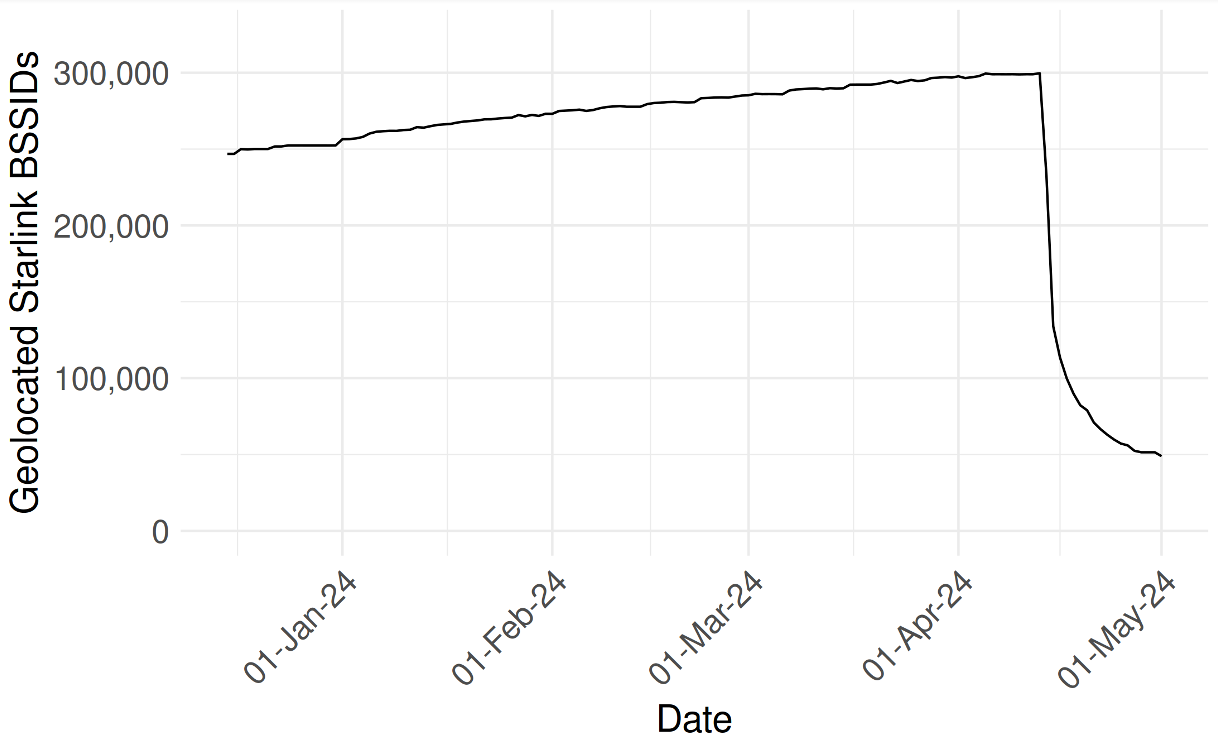
UMD researchers shared this graphic, which shows their ability to monitor the location and movement of Starlink devices by BSSID dropped precipitously in the past month.
They also shared a written statement they received from Starlink, which acknowledged that Starlink User Terminal routers originally used a static BSSID/MAC:
“In early 2023 a software update was released that randomized the main router BSSID. Subsequent software releases have included randomization of the BSSID of WiFi repeaters associated with the main router. Software updates that include the repeater randomization functionality are currently being deployed fleet-wide on a region-by-region basis. We believe the data outlined in your paper is based on Starlink main routers and or repeaters that were queried prior to receiving these randomization updates.”
The researchers also focused their geofencing on the Israel-Hamas war in Gaza, and were able to track the migration and disappearance of devices throughout the Gaza Strip as Israeli forces cut power to the country and bombing campaigns knocked out key infrastructure.
“As time progressed, the number of Gazan BSSIDs that are geolocatable continued to decline,” they wrote. “By the end of the month, only 28% of the original BSSIDs were still found in the Apple WPS.”
In late March 2024, Apple quietly updated its website to note that anyone can opt out of having the location of their wireless access points collected and shared by Apple — by appending “_nomap” to the end of the Wi-Fi access point’s name (SSID). Adding “_nomap” to your Wi-Fi network name also blocks Google from indexing its location.
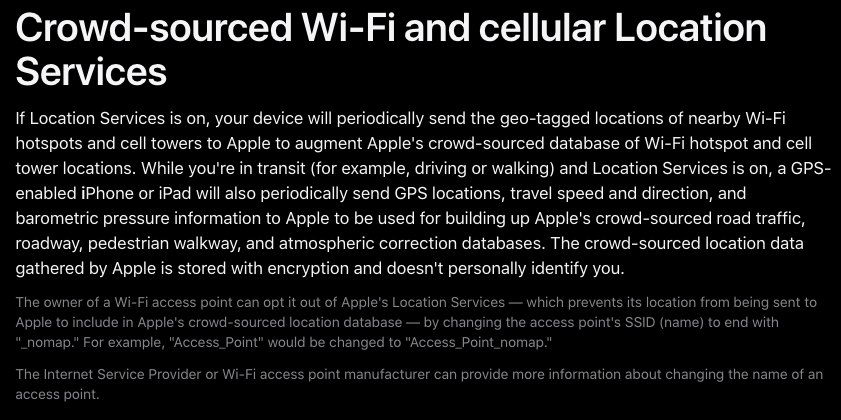
Apple updated its privacy and location services policy in March 2024 to allow people to opt out of having their Wi-Fi access point indexed by its service, by appending “_nomap” to the network’s name.
Asked about the changes, Apple said they have respected the “_nomap” flag on SSIDs for some time, but that this was only called out in a support article earlier this year.
Rye said Apple’s response addressed the most depressing aspect of their research: That there was previously no way for anyone to opt out of this data collection.
“You may not have Apple products, but if you have an access point and someone near you owns an Apple device, your BSSID will be in [Apple’s] database,” he said. “What’s important to note here is that every access point is being tracked, without opting in, whether they run an Apple device or not. Only after we disclosed this to Apple have they added the ability for people to opt out.”
The researchers said they hope Apple will consider additional safeguards, such as proactive ways to limit abuses of its location API.
“It’s a good first step,” Levin said of Apple’s privacy update in March. “But this data represents a really serious privacy vulnerability. I would hope Apple would put further restrictions on the use of its API, like rate-limiting these queries to keep people from accumulating massive amounts of data like we did.”
The UMD researchers said they omitted certain details from their study to protect the users they were able to track, noting that the methods they used could present risks for those fleeing abusive relationships or stalkers.
“We observe routers move between cities and countries, potentially representing their owner’s relocation or a business transaction between an old and new owner,” they wrote. “While there is not necessarily a 1-to-1 relationship between Wi-Fi routers and users, home routers typically only have several. If these users are vulnerable populations, such as those fleeing intimate partner violence or a stalker, their router simply being online can disclose their new location.”
The researchers said Wi-Fi access points that can be created using a mobile device’s built-in cellular modem do not create a location privacy risk for their users because mobile phone hotspots will choose a random BSSID when activated.
“Modern Android and iOS devices will choose a random BSSID when you go into hotspot mode,” he said. “Hotspots are already implementing the strongest recommendations for privacy protections. It’s other types of devices that don’t do that.”
For example, they discovered that certain commonly used travel routers compound the potential privacy risks.
“Because travel routers are frequently used on campers or boats, we see a significant number of them move between campgrounds, RV parks, and marinas,” the UMD duo wrote. “They are used by vacationers who move between residential dwellings and hotels. We have evidence of their use by military members as they deploy from their homes and bases to war zones.”
A copy of the UMD research is available here (PDF).
Update, May 22, 4:54 p.m. ET: Added response from Apple.
Microsoft today released updates to fix more than 60 security holes in Windows computers and supported software, including two “zero-day” vulnerabilities in Windows that are already being exploited in active attacks. There are also important security patches available for macOS and Adobe users, and for the Chrome Web browser, which just patched its own zero-day flaw.

First, the zero-days. CVE-2024-30051 is an “elevation of privilege” bug in a core Windows library. Satnam Narang at Tenable said this flaw is being used as part of post-compromise activity to elevate privileges as a local attacker.
“CVE-2024-30051 is used to gain initial access into a target environment and requires the use of social engineering tactics via email, social media or instant messaging to convince a target to open a specially crafted document file,” Narang said. “Once exploited, the attacker can bypass OLE mitigations in Microsoft 365 and Microsoft Office, which are security features designed to protect end users from malicious files.”
Kaspersky Lab, one of two companies credited with reporting exploitation of CVE-2024-30051 to Microsoft, has published a fascinating writeup on how they discovered the exploit in a file shared with Virustotal.com.
Kaspersky said it has since seen the exploit used together with QakBot and other malware. Emerging in 2007 as a banking trojan, QakBot (a.k.a. Qbot and Pinkslipbot) has morphed into an advanced malware strain now used by multiple cybercriminal groups to prepare newly compromised networks for ransomware infestations.
CVE-2024-30040 is a security feature bypass in MSHTML, a component that is deeply tied to the default Web browser on Windows systems. Microsoft’s advisory on this flaw is fairly sparse, but Kevin Breen from Immersive Labs said this vulnerability also affects Office 365 and Microsoft Office applications.
“Very little information is provided and the short description is painfully obtuse,” Breen said of Microsoft’s advisory on CVE-2024-30040.
The only vulnerability fixed this month that earned Microsoft’s most-dire “critical” rating is CVE-2024-30044, a flaw in Sharepoint that Microsoft said is likely to be exploited. Tenable’s Narang notes that exploitation of this bug requires an attacker to be authenticated to a vulnerable SharePoint Server with Site Owner permissions (or higher) first and to take additional steps in order to exploit this flaw, which makes this flaw less likely to be widely exploited as most attackers follow the path of least resistance.
Five days ago, Google released a security update for Chrome that fixes a zero-day in the popular browser. Chrome usually auto-downloads any available updates, but it still may require a complete restart of the browser to install them. If you use Chrome and see a “Relaunch to update” message in the upper right corner of the browser, it’s time to restart.
Apple has just shipped macOS Sonoma 14.5 update, which includes nearly two dozen security patches. To ensure your Mac is up-to-date, go to System Settings, General tab, then Software Update and follow any prompts.
Finally, Adobe has critical security patches available for a range of products, including Acrobat, Reader, Illustrator, Adobe Substance 3D Painter, Adobe Aero, Adobe Animate and Adobe Framemaker.
Regardless of whether you use a Mac or Windows system (or something else), it’s always a good idea to backup your data and or system before applying any security updates. For a closer look at the individual fixes released by Microsoft today, check out the complete list over at the SANS Internet Storm Center. Anyone in charge of maintaining Windows systems in an enterprise environment should keep an eye on askwoody.com, which usually has the scoop on any wonky Windows patches.
Update, May 15, 8:28 a.m.: Corrected misattribution of CVE-2024-30051.
Last week, the United States joined the U.K. and Australia in sanctioning and charging a Russian man named Dmitry Yuryevich Khoroshev as the leader of the infamous LockBit ransomware group. LockBit’s leader “LockBitSupp” claims the feds named the wrong guy, saying the charges don’t explain how they connected him to Khoroshev. This post examines the activities of Khoroshev’s many alter egos on the cybercrime forums, and tracks the career of a gifted malware author who has written and sold malicious code for the past 14 years.

Dmitry Yuryevich Khoroshev. Image: treasury.gov.
On May 7, the U.S. Department of Justice indicted Khoroshev on 26 criminal counts, including extortion, wire fraud, and conspiracy. The government alleges Khoroshev created, sold and used the LockBit ransomware strain to personally extort more than $100 million from hundreds of victim organizations, and that LockBit as a group extorted roughly half a billion dollars over four years.
Federal investigators say Khoroshev ran LockBit as a “ransomware-as-a-service” operation, wherein he kept 20 percent of any ransom amount paid by a victim organization infected with his code, with the remaining 80 percent of the payment going to LockBit affiliates responsible for spreading the malware.
Financial sanctions levied against Khoroshev by the U.S. Department of the Treasury listed his known email and street address (in Voronezh, in southwest Russia), passport number, and even his tax ID number (hello, Russian tax authorities). The Treasury filing says Khoroshev used the emails sitedev5@yandex.ru, and khoroshev1@icloud.com.
According to DomainTools.com, the address sitedev5@yandex.ru was used to register at least six domains, including a Russian business registered in Khoroshev’s name called tkaner.com, which is a blog about clothing and fabrics.
A search at the breach-tracking service Constella Intelligence on the phone number in Tkaner’s registration records — 7.9521020220 — brings up multiple official Russian government documents listing the number’s owner as Dmitri Yurievich Khoroshev.
Another domain registered to that phone number was stairwell[.]ru, which at one point advertised the sale of wooden staircases. Constella finds that the email addresses webmaster@stairwell.ru and admin@stairwell.ru used the password 225948.
DomainTools reports that stairwell.ru for several years included the registrant’s name as “Dmitrij Ju Horoshev,” and the email address pin@darktower.su. According to Constella, this email address was used in 2010 to register an account for a Dmitry Yurievich Khoroshev from Voronezh, Russia at the hosting provider firstvds.ru.

Image: Shutterstock.
Cyber intelligence firm Intel 471 finds that pin@darktower.ru was used by a Russian-speaking member called Pin on the English-language cybercrime forum Opensc. Pin was active on Opensc around March 2012, and authored 13 posts that mostly concerned data encryption issues, or how to fix bugs in code.
Other posts concerned custom code Pin claimed to have written that would bypass memory protections on Windows XP and Windows 7 systems, and inject malware into memory space normally allocated to trusted applications on a Windows machine.
Pin also was active at that same time on the Russian-language security forum Antichat, where they told fellow forum members to contact them at the ICQ instant messenger number 669316.
A search on the ICQ number 669316 at Intel 471 shows that in April 2011, a user by the name NeroWolfe joined the Russian cybercrime forum Zloy using the email address d.horoshev@gmail.com, and from an Internet address in Voronezh, RU.
Constella finds the same password tied to webmaster@stairwell.ru (225948) was used by the email address 3k@xakep.ru, which Intel 471 says was registered to more than a dozen NeroWolfe accounts across just as many Russian cybercrime forums between 2011 and 2015.
NeroWolfe’s introductory post to the forum Verified in Oct. 2011 said he was a system administrator and C++ coder.
“Installing SpyEYE, ZeuS, any DDoS and spam admin panels,” NeroWolfe wrote. This user said they specialize in developing malware, creating computer worms, and crafting new ways to hijack Web browsers.

“I can provide my portfolio on request,” NeroWolfe wrote. “P.S. I don’t modify someone else’s code or work with someone else’s frameworks.”
In April 2013, NeroWolfe wrote in a private message to another Verified forum user that he was selling a malware “loader” program that could bypass all of the security protections on Windows XP and Windows 7.
“The access to the network is slightly restricted,” NeroWolfe said of the loader, which he was selling for $5,000. “You won’t manage to bind a port. However, it’s quite possible to send data. The code is written in C.”
In an October 2013 discussion on the cybercrime forum Exploit, NeroWolfe weighed in on the karmic ramifications of ransomware. At the time, ransomware-as-a-service didn’t exist yet, and many members of Exploit were still making good money from “lockers,” relatively crude programs that locked the user out of their system until they agreed to make a small payment (usually a few hundred dollars via prepaid Green Dot cards).
Lockers, which presaged the coming ransomware scourge, were generally viewed by the Russian-speaking cybercrime forums as harmless moneymaking opportunities, because they usually didn’t seek to harm the host computer or endanger files on the system. Also, there were still plenty of locker programs that aspiring cybercriminals could either buy or rent to make a steady income.
NeroWolfe reminded forum denizens that they were just as vulnerable to ransomware attacks as their would-be victims, and that what goes around comes around.
“Guys, do you have a conscience?,” NeroWolfe wrote. “Okay, lockers, network gopstop aka business in Russian. The last thing was always squeezed out of the suckers. But encoders, no one is protected from them, including the local audience.”
If Khoroshev was ever worried that someone outside of Russia might be able to connect his early hacker handles to his real life persona, that’s not clear from reviewing his history online. In fact, the same email address tied to so many of NeroWolfe’s accounts on the forums — 3k@xakep.ru — was used in 2011 to create an account for a Dmitry Yurevich Khoroshev on the Russian social media network Vkontakte.
NeroWolfe seems to have abandoned all of his forum accounts sometime in 2016. In November 2016, an exploit[.]ru member filed an official complaint against NeroWolfe, saying NeroWolfe had been paid $2,000 to produce custom code but never finished the project and vanished.
It’s unclear what happened to NeroWolfe or to Khoroshev during this time. Maybe he got arrested, or some close associates did. Perhaps he just decided it was time to lay low and hit the reset on his operational security efforts, given his past failures in this regard. It’s also possible NeroWolfe landed a real job somewhere for a few years, fathered a child, and/or had to put his cybercrime career on hold.
Or perhaps Khoroshev saw the coming ransomware industry for the endless pot of gold that it was about to become, and then dedicated himself to working on custom ransomware code. That’s what the government believes.
The indictment against Khoroshev says he used the hacker nickname Putinkrab, and Intel 471 says this corresponds to a username that was first registered across three major Russian cybercrime forums in early 2019.
KrebsOnSecurity could find no obvious connections between Putinkrab and any of Khoroshev’s older identities. However, if Putinkrab was Khoroshev, he would have learned from his past mistakes and started fresh with a new identity (which he did). But also, it is likely the government hasn’t shared all of the intelligence it has collected against him (more on that in a bit).
Putinkrab’s first posts on the Russian cybercrime forums XSS, Exploit and UFOLabs saw this user selling ransomware source code written in C.
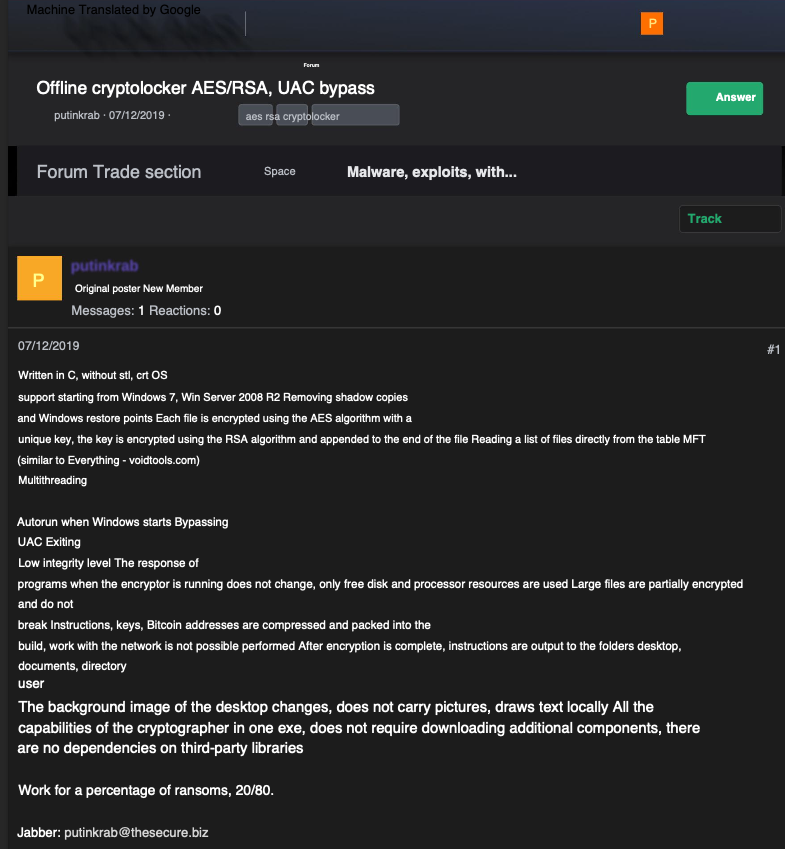
A machine-translated ad for ransomware source code from Putinkrab on the Russian language cybercrime forum UFOlabs in 2019. Image: Ke-la.com.
In April 2019, Putkinkrab offered an affiliate program that would run on top of his custom-made ransomware code.
“I want to work for a share of the ransoms: 20/80,” Putinkrab wrote on Exploit. “20 percent is my percentage for the work, you get 80% of the ransoms. The percentage can be reduced up to 10/90 if the volumes are good. But now, temporarily, until the service is fully automated, we are working using a different algorithm.”
Throughout the summer of 2019, Putinkrab posted multiple updates to Exploit about new features being added to his ransomware strain, as well as novel evasion techniques to avoid detection by security tools. He also told forum members he was looking for investors for a new ransomware project based on his code.
In response to an Exploit member who complained that the security industry was making it harder to profit from ransomware, Putinkrab said that was because so many cybercriminals were relying on crappy ransomware code.
“The vast majority of top antiviruses have acquired behavioral analysis, which blocks 95% of crypto-lockers at their root,” Putinkrab wrote. “Cryptolockers made a lot of noise in the press, but lazy system administrators don’t make backups after that. The vast majority of cryptolockers are written by people who have little understanding of cryptography. Therefore, decryptors appear on the Internet, and with them the hope that files can be decrypted without paying a ransom. They just sit and wait. Contact with the owner of the key is lost over time.”
Putinkrab said he had every confidence his ransomware code was a game-changer, and a huge money machine.
“The game is just gaining momentum,” Putinkrab wrote. “Weak players lose and are eliminated.”
The rest of his response was structured like a poem:
“In this world, the strongest survive.
Our life is just a struggle.
The winner will be the smartest,
Who has his head on his shoulders.”
Putinkrab’s final post came on August 23, 2019. The Justice Department says the LockBit ransomware affiliate program was officially launched five months later. From there on out, the government says, Khoroshev adopted the persona of LockBitSupp. In his introductory post on Exploit, LockBit’s mastermind said the ransomware strain had been in development since September 2019.
The original LockBit malware was written in C (a language that NeroWolfe excelled at). Here’s the original description of LockBit, from its maker:
“The software is written in C and Assembler; encryption is performed through the I/O Completion Port; there is a port scanning local networks and an option to find all DFS, SMB, WebDAV network shares, an admin panel in Tor, automatic test decryption; a decryption tool is provided; there is a chat with Push notifications, a Jabber bot that forwards correspondence and an option to terminate services/processes in line which prevent the ransomware from opening files at a certain moment. The ransomware sets file permissions and removes blocking attributes, deletes shadow copies, clears logs and mounts hidden partitions; there is an option to drag-and-drop files/folders and a console/hidden mode. The ransomware encrypts files in parts in various places: the larger the file size, the more parts there are. The algorithms used are AES + RSA.
You are the one who determines the ransom amount after communicating with the victim. The ransom paid in any currency that suits you will be transferred to your wallets. The Jabber bot serves as an admin panel and is used for banning, providing decryption tools, chatting – Jabber is used for absolutely everything.”
Does the above timeline prove that NeroWolfe/Khoroshev is LockBitSupp? No. However, it does indicate Khoroshev was for many years deeply invested in countless schemes involving botnets, stolen data, and malware he wrote that others used to great effect. NeroWolfe’s many private messages from fellow forum members confirm this.
NeroWolfe’s specialty was creating custom code that employed novel stealth and evasion techniques, and he was always quick to volunteer his services on the forums whenever anyone was looking help on a malware project that called for a strong C or C++ programmer.
Someone with those qualifications — as well as demonstrated mastery of data encryption and decryption techniques — would have been in great demand by the ransomware-as-a-service industry that took off at around the same time NeroWolfe vanished from the forums.
Someone like that who is near or at the top of their game vis-a-vis their peers does not simply walk away from that level of influence, community status, and potential income stream unless forced to do so by circumstances beyond their immediate control.
It’s important to note that Putinkrab didn’t just materialize out of thin air in 2019 — suddenly endowed with knowledge about how to write advanced, stealthy ransomware strains. That knowledge clearly came from someone who’d already had years of experience building and deploying ransomware strains against real-life victim organizations.
Thus, whoever Putinkrab was before they adopted that moniker, it’s a safe bet they were involved in the development and use of earlier, highly successful ransomware strains. One strong possible candidate is Cerber ransomware, the most popular and effective affiliate program operating between early 2016 and mid-2017. Cerber thrived because it emerged as an early mover in the market for ransomware-as-a-service offerings.
In February 2024, the FBI seized LockBit’s cybercrime infrastructure on the dark web, following an apparently lengthy infiltration of the group’s operations. The United States has already indicted and sanctioned at least five other alleged LockBit ringleaders or affiliates, so presumably the feds have been able to draw additional resources from those investigations.
Also, it seems likely that the three national intelligence agencies involved in bringing these charges are not showing all of their cards. For example, the Treasury documents on Khoroshev mention a single cryptocurrency address, and yet experts interviewed for this story say there are no obvious clues connecting this address to Khoroshev or Putinkrab.
But given that LockBitSupp has been actively involved in Lockbit ransomware attacks against organizations for four years now, the government almost certainly has an extensive list of the LockBit leader’s various cryptocurrency addresses — and probably even his bank accounts in Russia. And no doubt the money trail from some of those transactions was traceable to its ultimate beneficiary (or close enough).
Not long after Khoroshev was charged as the leader of LockBit, a number of open-source intelligence accounts on Telegram began extending the information released by the Treasury Department. Within hours, these sleuths had unearthed more than a dozen credit card accounts used by Khoroshev over the past decade, as well as his various bank account numbers in Russia.
The point is, this post is based on data that’s available to and verifiable by KrebsOnSecurity. Woodward & Bernstein’s source in the Watergate investigation — Deep Throat — famously told the two reporters to “follow the money.” This is always excellent advice. But these days, that can be a lot easier said than done — especially with people who a) do not wish to be found, and b) don’t exactly file annual reports.
The United States joined the United Kingdom and Australia today in sanctioning 31-year-old Russian national Dmitry Yuryevich Khoroshev as the alleged leader of the infamous ransomware group LockBit. The U.S. Department of Justice also indicted Khoroshev and charged him with using Lockbit to attack more than 2,000 victims and extort at least $100 million in ransomware payments.

Image: U.K. National Crime Agency.
Khoroshev (Дмитрий Юрьевич Хорошев), a resident of Voronezh, Russia, was charged in a 26-count indictment by a grand jury in New Jersey.
“Dmitry Khoroshev conceived, developed, and administered Lockbit, the most prolific ransomware variant and group in the world, enabling himself and his affiliates to wreak havoc and cause billions of dollars in damage to thousands of victims around the globe,” U.S. Attorney Philip R. Sellinger said in a statement released by the Justice Department.
The indictment alleges Khoroshev acted as the LockBit ransomware group’s developer and administrator from its inception in September 2019 through May 2024, and that he typically received a 20 percent share of each ransom payment extorted from LockBit victims.
The government says LockBit victims included individuals, small businesses, multinational corporations, hospitals, schools, nonprofit organizations, critical infrastructure, and government and law-enforcement agencies.
“Khoroshev and his co-conspirators extracted at least $500 million in ransom payments from their victims and caused billions of dollars in broader losses, such as lost revenue, incident response, and recovery,” the DOJ said. “The LockBit ransomware group attacked more than 2,500 victims in at least 120 countries, including 1,800 victims in the United States.”
The unmasking of LockBitSupp comes nearly three months after U.S. and U.K. authorities seized the darknet websites run by LockBit, retrofitting it with press releases about the law enforcement action and free tools to help LockBit victims decrypt infected systems.

The feds used the existing design on LockBit’s victim shaming website to feature press releases and free decryption tools.
One of the blog captions that authorities left on the seized site was a teaser page that read, “Who is LockbitSupp?,” which promised to reveal the true identity of the ransomware group leader. That item featured a countdown clock until the big reveal, but when the site’s timer expired no such details were offered.
Following the FBI’s raid, LockBitSupp took to Russian cybercrime forums to assure his partners and affiliates that the ransomware operation was still fully operational. LockBitSupp also raised another set of darknet websites that soon promised to release data stolen from a number of LockBit victims ransomed prior to the FBI raid.
One of the victims LockBitSupp continued extorting was Fulton County, Ga. Following the FBI raid, LockbitSupp vowed to release sensitive documents stolen from the county court system unless paid a ransom demand before LockBit’s countdown timer expired. But when Fulton County officials refused to pay and the timer expired, no stolen records were ever published. Experts said it was likely the FBI had in fact seized all of LockBit’s stolen data.
LockBitSupp also bragged that their real identity would never be revealed, and at one point offered to pay $10 million to anyone who could discover their real name.
KrebsOnSecurity has been in intermittent contact with LockBitSupp for several months over the course of reporting on different LockBit victims. Reached at the same ToX instant messenger identity that the ransomware group leader has promoted on Russian cybercrime forums, LockBitSupp claimed the authorities named the wrong guy.
“It’s not me,” LockBitSupp replied in Russian. “I don’t understand how the FBI was able to connect me with this poor guy. Where is the logical chain that it is me? Don’t you feel sorry for a random innocent person?”
LockBitSupp, who now has a $10 million bounty for his arrest from the U.S. Department of State, has been known to be flexible with the truth. The Lockbit group routinely practiced “double extortion” against its victims — requiring one ransom payment for a key to unlock hijacked systems, and a separate payment in exchange for a promise to delete data stolen from its victims.
But Justice Department officials say LockBit never deleted its victim data, regardless of whether those organizations paid a ransom to keep the information from being published on LockBit’s victim shaming website.
Khoroshev is the sixth person officially indicted as active members of LockBit. The government says Russian national Artur Sungatov used LockBit ransomware against victims in manufacturing, logistics, insurance and other companies throughout the United States.
Ivan Gennadievich Kondratyev, a.k.a. “Bassterlord,” allegedly deployed LockBit against targets in the United States, Singapore, Taiwan, and Lebanon. Kondratyev is also charged (PDF) with three criminal counts arising from his alleged use of the Sodinokibi (aka “REvil“) ransomware variant to encrypt data, exfiltrate victim information, and extort a ransom payment from a corporate victim based in Alameda County, California.
In May 2023, U.S. authorities unsealed indictments against two alleged LockBit affiliates, Mikhail “Wazawaka” Matveev and Mikhail Vasiliev. In January 2022, KrebsOnSecurity published Who is the Network Access Broker ‘Wazawaka,’ which followed clues from Wazawaka’s many pseudonyms and contact details on the Russian-language cybercrime forums back to a 31-year-old Mikhail Matveev from Abaza, RU.
Matveev remains at large, presumably still in Russia. Meanwhile, the U.S. Department of State has a standing $10 million reward offer for information leading to Matveev’s arrest.
Vasiliev, 35, of Bradford, Ontario, Canada, is in custody in Canada awaiting extradition to the United States (the complaint against Vasiliev is at this PDF).
In June 2023, Russian national Ruslan Magomedovich Astamirov was charged in New Jersey for his participation in the LockBit conspiracy, including the deployment of LockBit against victims in Florida, Japan, France, and Kenya. Astamirov is currently in custody in the United States awaiting trial.
The Justice Department is urging victims targeted by LockBit to contact the FBI at https://lockbitvictims.ic3.gov/ to file an official complaint, and to determine whether affected systems can be successfully decrypted.
Virtual private networking (VPN) companies market their services as a way to prevent anyone from snooping on your Internet usage. But new research suggests this is a dangerous assumption when connecting to a VPN via an untrusted network, because attackers on the same network could force a target’s traffic off of the protection provided by their VPN without triggering any alerts to the user.

Image: Shutterstock.
When a device initially tries to connect to a network, it broadcasts a message to the entire local network stating that it is requesting an Internet address. Normally, the only system on the network that notices this request and replies is the router responsible for managing the network to which the user is trying to connect.
The machine on a network responsible for fielding these requests is called a Dynamic Host Configuration Protocol (DHCP) server, which will issue time-based leases for IP addresses. The DHCP server also takes care of setting a specific local address — known as an Internet gateway — that all connecting systems will use as a primary route to the Web.
VPNs work by creating a virtual network interface that serves as an encrypted tunnel for communications. But researchers at Leviathan Security say they’ve discovered it’s possible to abuse an obscure feature built into the DHCP standard so that other users on the local network are forced to connect to a rogue DHCP server.
“Our technique is to run a DHCP server on the same network as a targeted VPN user and to also set our DHCP configuration to use itself as a gateway,” Leviathan researchers Lizzie Moratti and Dani Cronce wrote. “When the traffic hits our gateway, we use traffic forwarding rules on the DHCP server to pass traffic through to a legitimate gateway while we snoop on it.”
The feature being abused here is known as DHCP option 121, and it allows a DHCP server to set a route on the VPN user’s system that is more specific than those used by most VPNs. Abusing this option, Leviathan found, effectively gives an attacker on the local network the ability to set up routing rules that have a higher priority than the routes for the virtual network interface that the target’s VPN creates.
“Pushing a route also means that the network traffic will be sent over the same interface as the DHCP server instead of the virtual network interface,” the Leviathan researchers said. “This is intended functionality that isn’t clearly stated in the RFC [standard]. Therefore, for the routes we push, it is never encrypted by the VPN’s virtual interface but instead transmitted by the network interface that is talking to the DHCP server. As an attacker, we can select which IP addresses go over the tunnel and which addresses go over the network interface talking to our DHCP server.”
Leviathan found they could force VPNs on the local network that already had a connection to arbitrarily request a new one. In this well-documented tactic, known as a DHCP starvation attack, an attacker floods the DHCP server with requests that consume all available IP addresses that can be allocated. Once the network’s legitimate DHCP server is completely tied up, the attacker can then have their rogue DHCP server respond to all pending requests.
“This technique can also be used against an already established VPN connection once the VPN user’s host needs to renew a lease from our DHCP server,” the researchers wrote. “We can artificially create that scenario by setting a short lease time in the DHCP lease, so the user updates their routing table more frequently. In addition, the VPN control channel is still intact because it already uses the physical interface for its communication. In our testing, the VPN always continued to report as connected, and the kill switch was never engaged to drop our VPN connection.”
The researchers say their methods could be used by an attacker who compromises a DHCP server or wireless access point, or by a rogue network administrator who owns the infrastructure themselves and maliciously configures it. Alternatively, an attacker could set up an “evil twin” wireless hotspot that mimics the signal broadcast by a legitimate provider.
Bill Woodcock is executive director at Packet Clearing House, a nonprofit based in San Francisco. Woodcock said Option 121 has been included in the DHCP standard since 2002, which means the attack described by Leviathan has technically been possible for the last 22 years.
“They’re realizing now that this can be used to circumvent a VPN in a way that’s really problematic, and they’re right,” Woodcock said.
Woodcock said anyone who might be a target of spear phishing attacks should be very concerned about using VPNs on an untrusted network.
“Anyone who is in a position of authority or maybe even someone who is just a high net worth individual, those are all very reasonable targets of this attack,” he said. “If I were trying to do an attack against someone at a relatively high security company and I knew where they typically get their coffee or sandwich at twice a week, this is a very effective tool in that toolbox. I’d be a little surprised if it wasn’t already being exploited in that way, because again this isn’t rocket science. It’s just thinking a little outside the box.”
Successfully executing this attack on a network likely would not allow an attacker to see all of a target’s traffic or browsing activity. That’s because for the vast majority of the websites visited by the target, the content is encrypted (the site’s address begins with https://). However, an attacker would still be able to see the metadata — such as the source and destination addresses — of any traffic flowing by.
KrebsOnSecurity shared Leviathan’s research with John Kristoff, founder of dataplane.org and a PhD candidate in computer science at the University of Illinois Chicago. Kristoff said practically all user-edge network gear, including WiFi deployments, support some form of rogue DHCP server detection and mitigation, but that it’s unclear how widely deployed those protections are in real-world environments.
“However, and I think this is a key point to emphasize, an untrusted network is an untrusted network, which is why you’re usually employing the VPN in the first place,” Kristoff said. “If [the] local network is inherently hostile and has no qualms about operating a rogue DHCP server, then this is a sneaky technique that could be used to de-cloak some traffic – and if done carefully, I’m sure a user might never notice.”
According to Leviathan, there are several ways to minimize the threat from rogue DHCP servers on an unsecured network. One is using a device powered by the Android operating system, which apparently ignores DHCP option 121.
Relying on a temporary wireless hotspot controlled by a cellular device you own also effectively blocks this attack.
“They create a password-locked LAN with automatic network address translation,” the researchers wrote of cellular hot-spots. “Because this network is completely controlled by the cellular device and requires a password, an attacker should not have local network access.”
Leviathan’s Moratti said another mitigation is to run your VPN from inside of a virtual machine (VM) — like Parallels, VMware or VirtualBox. VPNs run inside of a VM are not vulnerable to this attack, Moratti said, provided they are not run in “bridged mode,” which causes the VM to replicate another node on the network.
In addition, a technology called “deep packet inspection” can be used to deny all in- and outbound traffic from the physical interface except for the DHCP and the VPN server. However, Leviathan says this approach opens up a potential “side channel” attack that could be used to determine the destination of traffic.
“This could be theoretically done by performing traffic analysis on the volume a target user sends when the attacker’s routes are installed compared to the baseline,” they wrote. “In addition, this selective denial-of-service is unique as it could be used to censor specific resources that an attacker doesn’t want a target user to connect to even while they are using the VPN.”
Moratti said Leviathan’s research shows that many VPN providers are currently making promises to their customers that their technology can’t keep.
“VPNs weren’t designed to keep you more secure on your local network, but to keep your traffic more secure on the Internet,” Moratti said. “When you start making assurances that your product protects people from seeing your traffic, there’s an assurance or promise that can’t be met.”
A copy of Leviathan’s research, along with code intended to allow others to duplicate their findings in a lab environment, is available here.

For nearly a dozen years, residents of South Carolina have been kept in the dark by state and federal investigators over who was responsible for hacking into the state’s revenue department in 2012 and stealing tax and bank account information for 3.6 million people. The answer may no longer be a mystery: KrebsOnSecurity found compelling clues suggesting the intrusion was carried out by the same Russian hacking crew that stole of millions of payment card records from big box retailers like Home Depot and Target in the years that followed.
Questions about who stole tax and financial data on roughly three quarters of all South Carolina residents came to the fore last week at the confirmation hearing of Mark Keel, who was appointed in 2011 by Gov. Nikki Haley to head the state’s law enforcement division. If approved, this would be Keel’s third six-year term in that role.
The Associated Press reports that Keel was careful not to release many details about the breach at his hearing, telling lawmakers he knows who did it but that he wasn’t ready to name anyone.
“I think the fact that we didn’t come up with a whole lot of people’s information that got breached is a testament to the work that people have done on this case,” Keel asserted.
A ten-year retrospective published in 2022 by The Post and Courier in Columbia, S.C. said investigators determined the breach began on Aug. 13, 2012, after a state IT contractor clicked a malicious link in an email. State officials said they found out about the hack from federal law enforcement on October 10, 2012.
KrebsOnSecurity examined posts across dozens of cybercrime forums around that time, and found only one instance of someone selling large volumes of tax data in the year surrounding the breach date.
On Oct. 7, 2012 — three days before South Carolina officials say they first learned of the intrusion — a notorious cybercriminal who goes by the handle “Rescator” advertised the sale of “a database of the tax department of one of the states.”
“Bank account information, SSN and all other information,” Rescator’s sales thread on the Russian-language crime forum Embargo read. “If you purchase the entire database, I will give you access to it.”
A week later, Rescator posted a similar offer on the exclusive Russian forum Mazafaka, saying he was selling information from a U.S. state tax database, without naming the state. Rescator said the data exposed included Social Security Number (SSN), employer, name, address, phone, taxable income, tax refund amount, and bank account number.
“There is a lot of information, I am ready to sell the entire database, with access to the database, and in parts,” Rescator told Mazafaka members. “There is also information on corporate taxpayers.”
On Oct. 26, 2012, the state announced the breach publicly. State officials said they were working with investigators from the U.S. Secret Service and digital forensics experts from Mandiant, which produced an incident report (PDF) that was later published by South Carolina Dept. of Revenue. KrebsOnSecurity sought comment from the Secret Service, South Carolina prosecutors, and Mr. Keel’s office. This story will be updated if any of them respond. Update: The Secret Service declined to comment.
On Nov. 18, 2012, Rescator told fellow denizens of the forum Verified he was selling a database of 65,000 records with bank account information from several smaller, regional financial institutions. Rescator’s sales thread on Verified listed more than a dozen database fields, including account number, name, address, phone, tax ID, date of birth, employer and occupation.
Asked to provide more context about the database for sale, Rescator told forum members the database included financial records related to tax filings of a U.S. state. Rescator added that there was a second database of around 80,000 corporations that included social security numbers, names and addresses, but no financial information.
The AP says South Carolina paid $12 million to Experian for identity theft protection and credit monitoring for its residents after the breach.
“At the time, it was one of the largest breaches in U.S. history but has since been surpassed greatly by hacks to Equifax, Yahoo, Home Depot, Target and PlayStation,” the AP’s Jeffrey Collins wrote.
As it happens, Rescator’s criminal hacking crew was directly responsible for the 2013 breach at Target and the 2014 hack of Home Depot. The Target intrusion saw Rescator’s cybercrime shops selling roughly 40 million stolen payment cards, and 56 million cards from Home Depot customers.
Who is Rescator? On Dec. 14, 2023, KrebsOnSecurity published the results of a 10-year investigation into the identity of Rescator, a.k.a. Mikhail Borisovich Shefel, a 36-year-old who lives in Moscow and who recently changed his last name to Lenin.

Mr. Keel’s assertion that somehow the efforts of South Carolina officials following the breach may have lessened its impact on citizens seems unlikely. The stolen tax and financial data appears to have been sold openly on cybercrime forums by one of the Russian underground’s most aggressive and successful hacking crews.
While there are no indications from reviewing forum posts that Rescator ever sold the data, his sales threads came at a time when the incidence of tax refund fraud was skyrocketing.
Tax-related identity theft occurs when someone uses a stolen identity and SSN to file a tax return in that person’s name claiming a fraudulent refund. Victims usually first learn of the crime after having their returns rejected because scammers beat them to it. Even those who are not required to file a return can be victims of refund fraud, as can those who are not actually owed a refund from the U.S. Internal Revenue Service (IRS).
According to a 2013 report from the Treasury Inspector General’s office, the IRS issued nearly $4 billion in bogus tax refunds in 2012, and more than $5.8 billion in 2013. The money largely was sent to people who stole SSNs and other information on U.S. citizens, and then filed fraudulent tax returns on those individuals claiming a large refund but at a different address.
It remains unclear why Shefel has never been officially implicated in the breaches at Target, Home Depot, or in South Carolina. It may be that Shefel has been indicted, and that those indictments remain sealed for some reason. Perhaps prosecutors were hoping Shefel would decide to leave Russia, at which point it would be easier to apprehend him if he believed no one was looking for him.
But all signs are that Shefel is deeply rooted in Russia, and has no plans to leave. In January 2024, authorities in Australia, the United States and the U.K. levied financial sanctions against 33-year-old Russian man Aleksandr Ermakov for allegedly stealing data on 10 million customers of the Australian health insurance giant Medibank.
A week after those sanctions were put in place, KrebsOnSecurity published a deep dive on Ermakov, which found that he co-ran a Moscow-based IT security consulting business along with Mikhail Shefel called Shtazi-IT.

A Google-translated version of Shtazi dot ru. Image: Archive.org.
The U.S. government is warning that “smart locks” securing entry to an estimated 50,000 dwellings nationwide contain hard-coded credentials that can be used to remotely open any of the locks. The lock’s maker Chirp Systems remains unresponsive, even though it was first notified about the critical weakness in March 2021. Meanwhile, Chirp’s parent company, RealPage, Inc., is being sued by multiple U.S. states for allegedly colluding with landlords to illegally raise rents.

On March 7, 2024, the U.S. Cybersecurity & Infrastructure Security Agency (CISA) warned about a remotely exploitable vulnerability with “low attack complexity” in Chirp Systems smart locks.
“Chirp Access improperly stores credentials within its source code, potentially exposing sensitive information to unauthorized access,” CISA’s alert warned, assigning the bug a CVSS (badness) rating of 9.1 (out of a possible 10). “Chirp Systems has not responded to requests to work with CISA to mitigate this vulnerability.”
Matt Brown, the researcher CISA credits with reporting the flaw, is a senior systems development engineer at Amazon Web Services. Brown said he discovered the weakness and reported it to Chirp in March 2021, after the company that manages his apartment building started using Chirp smart locks and told everyone to install Chirp’s app to get in and out of their apartments.
“I use Android, which has a pretty simple workflow for downloading and decompiling the APK apps,” Brown told KrebsOnSecurity. “Given that I am pretty picky about what I trust on my devices, I downloaded Chirp and after decompiling, found that they were storing passwords and private key strings in a file.”
Using those hard-coded credentials, Brown found an attacker could then connect to an application programming interface (API) that Chirp uses which is managed by smart lock vendor August.com, and use that to enumerate and remotely lock or unlock any door in any building that uses the technology.
Update, April 18, 11:55 a.m. ET: August has provided a statement saying it does not believe August or Yale locks are vulnerable to the hack described by Brown.
“We were recently made aware of a vulnerability disclosure regarding access control systems provided by Chirp, using August and Yale locks in multifamily housing,” the company said. “Upon learning of these reports, we immediately and thoroughly investigated these claims. Our investigation found no evidence that would substantiate the vulnerability claims in either our product or Chirp’s as it relates to our systems.”
Update, April 25, 2:45 p.m. ET: Based on feedback from Chirp, CISA has downgraded the severity of this flaw and revised their security advisory to say that the hard-coded credentials do not appear to expose the devices to remote locking or unlocking. CISA says the hardcoded credentials could be used by an attacker within the range of Bluetooth (~30 meters) “to change the configuration settings within the Bluetooth beacon, effectively removing Bluetooth visibility from the device. This does not affect the device’s ability to lock or unlock access points, and access points can still be operated remotely by unauthorized users via other means.”
Brown said when he complained to his leasing office, they sold him a small $50 key fob that uses Near-Field Communications (NFC) to toggle the lock when he brings the fob close to his front door. But he said the fob doesn’t eliminate the ability for anyone to remotely unlock his front door using the exposed credentials and the Chirp mobile app.
Also, the fobs pass the credentials to his front door over the air in plain text, meaning someone could clone the fob just by bumping against him with a smartphone app made to read and write NFC tags.
Neither August nor Chirp Systems responded to requests for comment. It’s unclear exactly how many apartments and other residences are using the vulnerable Chirp locks, but multiple articles about the company from 2020 state that approximately 50,000 units use Chirp smart locks with August’s API.
Roughly a year before Brown reported the flaw to Chirp Systems, the company was bought by RealPage, a firm founded in 1998 as a developer of multifamily property management and data analytics software. In 2021, RealPage was acquired by the private equity giant Thoma Bravo.
Brown said the exposure he found in Chirp’s products is “an obvious flaw that is super easy to fix.”
“It’s just a matter of them being motivated to do it,” he said. “But they’re part of a private equity company now, so they’re not answerable to anybody. It’s too bad, because it’s not like residents of [the affected] properties have another choice. It’s either agree to use the app or move.”
In October 2022, an investigation by ProPublica examined RealPage’s dominance in the rent-setting software market, and that it found “uses a mysterious algorithm to help landlords push the highest possible rents on tenants.”
“For tenants, the system upends the practice of negotiating with apartment building staff,” ProPublica found. “RealPage discourages bargaining with renters and has even recommended that landlords in some cases accept a lower occupancy rate in order to raise rents and make more money. One of the algorithm’s developers told ProPublica that leasing agents had ‘too much empathy’ compared to computer generated pricing.”
Last year, the U.S. Department of Justice threw its weight behind a massive lawsuit filed by dozens of tenants who are accusing the $9 billion apartment software company of helping landlords collude to inflate rents.
In February 2024, attorneys general for Arizona and the District of Columbia sued RealPage, alleging RealPage’s software helped create a rental monopoly.
The U.S. Cybersecurity and Infrastructure Security Agency (CISA) said today it is investigating a breach at business intelligence company Sisense, whose products are designed to allow companies to view the status of multiple third-party online services in a single dashboard. CISA urged all Sisense customers to reset any credentials and secrets that may have been shared with the company, which is the same advice Sisense gave to its customers Wednesday evening.

New York City based Sisense has more than a thousand customers across a range of industry verticals, including financial services, telecommunications, healthcare and higher education. On April 10, Sisense Chief Information Security Officer Sangram Dash told customers the company had been made aware of reports that “certain Sisense company information may have been made available on what we have been advised is a restricted access server (not generally available on the internet.)”
“We are taking this matter seriously and promptly commenced an investigation,” Dash continued. “We engaged industry-leading experts to assist us with the investigation. This matter has not resulted in an interruption to our business operations. Out of an abundance of caution, and while we continue to investigate, we urge you to promptly rotate any credentials that you use within your Sisense application.”
In its alert, CISA said it was working with private industry partners to respond to a recent compromise discovered by independent security researchers involving Sisense.
“CISA is taking an active role in collaborating with private industry partners to respond to this incident, especially as it relates to impacted critical infrastructure sector organizations,” the sparse alert reads. “We will provide updates as more information becomes available.”
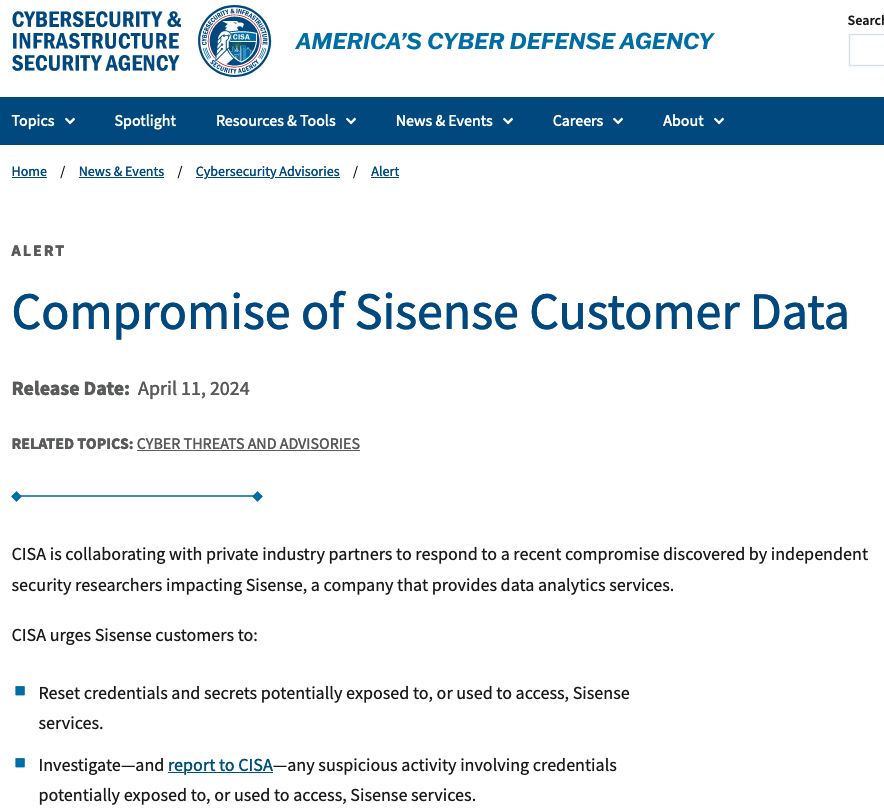
Sisense declined to comment when asked about the veracity of information shared by two trusted sources with close knowledge of the breach investigation. Those sources said the breach appears to have started when the attackers somehow gained access to the company’s Gitlab code repository, and in that repository was a token or credential that gave the bad guys access to Sisense’s Amazon S3 buckets in the cloud.
Customers can use Gitlab either as a solution that is hosted in the cloud at Gitlab.com, or as a self-managed deployment. KrebsOnSecurity understands that Sisense was using the self-managed version of Gitlab.
Both sources said the attackers used the S3 access to copy and exfiltrate several terabytes worth of Sisense customer data, which apparently included millions of access tokens, email account passwords, and even SSL certificates.
The incident raises questions about whether Sisense was doing enough to protect sensitive data entrusted to it by customers, such as whether the massive volume of stolen customer data was ever encrypted while at rest in these Amazon cloud servers.
It is clear, however, that unknown attackers now have all of the credentials that Sisense customers used in their dashboards.
The breach also makes clear that Sisense is somewhat limited in the clean-up actions that it can take on behalf of customers, because access tokens are essentially text files on your computer that allow you to stay logged in for extended periods of time — sometimes indefinitely. And depending on which service we’re talking about, it may be possible for attackers to re-use those access tokens to authenticate as the victim without ever having to present valid credentials.
Beyond that, it is largely up to Sisense customers to decide if and when they change passwords to the various third-party services that they’ve previously entrusted to Sisense.
Earlier today, a public relations firm working with Sisense reached out to learn if KrebsOnSecurity planned to publish any further updates on their breach (KrebsOnSecurity posted a screenshot of the CISO’s customer email to both LinkedIn and Mastodon on Wednesday evening). The PR rep said Sisense wanted to make sure they had an opportunity to comment before the story ran.
But when confronted with the details shared by my sources, Sisense apparently changed its mind.
“After consulting with Sisense, they have told me that they don’t wish to respond,” the PR rep said in an emailed reply.
Update, 6:49 p.m., ET: Added clarification that Sisense is using a self-hosted version of Gitlab, not the cloud version managed by Gitlab.com.
Also, Sisense’s CISO Dash just sent an update to customers directly. The latest advice from the company is far more detailed, and involves resetting a potentially large number of access tokens across multiple technologies, including Microsoft Active Directory credentials, GIT credentials, web access tokens, and any single sign-on (SSO) secrets or tokens.
The full message from Dash to customers is below:
“Good Afternoon,
We are following up on our prior communication of April 10, 2024, regarding reports that certain Sisense company information may have been made available on a restricted access server. As noted, we are taking this matter seriously and our investigation remains ongoing.
Our customers must reset any keys, tokens, or other credentials in their environment used within the Sisense application.
Specifically, you should:
– Change Your Password: Change all Sisense-related passwords on http://my.sisense.com
– Non-SSO:
– Replace the Secret in the Base Configuration Security section with your GUID/UUID.
– Reset passwords for all users in the Sisense application.
– Logout all users by running GET /api/v1/authentication/logout_all under Admin user.
– Single Sign-On (SSO):
– If you use SSO JWT for the user’s authentication in Sisense, you will need to update sso.shared_secret in Sisense and then use the newly generated value on the side of the SSO handler.
– We strongly recommend rotating the x.509 certificate for your SSO SAML identity provider.
– If you utilize OpenID, it’s imperative to rotate the client secret as well.
– Following these adjustments, update the SSO settings in Sisense with the revised values.
– Logout all users by running GET /api/v1/authentication/logout_all under Admin user.
– Customer Database Credentials: Reset credentials in your database that were used in the Sisense application to ensure continuity of connection between the systems.
– Data Models: Change all usernames and passwords in the database connection string in the data models.
– User Params: If you are using the User Params feature, reset them.
– Active Directory/LDAP: Change the username and user password of users whose authorization is used for AD synchronization.
– HTTP Authentication for GIT: Rotate the credentials in every GIT project.
– B2D Customers: Use the following API PATCH api/v2/b2d-connection in the admin section to update the B2D connection.
– Infusion Apps: Rotate the associated keys.
– Web Access Token: Rotate all tokens.
– Custom Email Server: Rotate associated credentials.
– Custom Code: Reset any secrets that appear in custom code Notebooks.
If you need any assistance, please submit a customer support ticket at https://community.sisense.com/t5/support-portal/bd-p/SupportPortal and mark it as critical. We have a dedicated response team on standby to assist with your requests.
At Sisense, we give paramount importance to security and are committed to our customers’ success. Thank you for your partnership and commitment to our mutual security.
Regards,
Sangram Dash
Chief Information Security Officer”
On April 9, Twitter/X began automatically modifying links that mention “twitter.com” to read “x.com” instead. But over the past 48 hours, dozens of new domain names have been registered that demonstrate how this change could be used to craft convincing phishing links — such as fedetwitter[.]com, which until very recently rendered as fedex.com in tweets.

The message displayed when one visits goodrtwitter.com, which Twitter/X displayed as goodrx.com in tweets and messages.
A search at DomainTools.com shows at least 60 domain names have been registered over the past two days for domains ending in “twitter.com,” although research so far shows the majority of these domains have been registered “defensively” by private individuals to prevent the domains from being purchased by scammers.
Those include carfatwitter.com, which Twitter/X truncated to carfax.com when the domain appeared in user messages or tweets. Visiting this domain currently displays a message that begins, “Are you serious, X Corp?”
Update: It appears Twitter/X has corrected its mistake, and no longer truncates any domain ending in “twitter.com” to “x.com.”
Original story:
The same message is on other newly registered domains, including goodrtwitter.com (goodrx.com), neobutwitter.com (neobux.com), roblotwitter.com (roblox.com), square-enitwitter.com (square-enix.com) and yandetwitter.com (yandex.com). The message left on these domains indicates they were defensively registered by a user on Mastodon whose bio says they are a systems admin/engineer. That profile has not responded to requests for comment.
A number of these new domains including “twitter.com” appear to be registered defensively by Twitter/X users in Japan. The domain netflitwitter.com (netflix.com, to Twitter/X users) now displays a message saying it was “acquired to prevent its use for malicious purposes,” along with a Twitter/X username.
The domain mentioned at the beginning of this story — fedetwitter.com — redirects users to the blog of a Japanese technology enthusiast. A user with the handle “amplest0e” appears to have registered space-twitter.com, which Twitter/X users would see as the CEO’s “space-x.com.” The domain “ametwitter.com” already redirects to the real americanexpress.com.
Some of the domains registered recently and ending in “twitter.com” currently do not resolve and contain no useful contact information in their registration records. Those include firefotwitter[.]com (firefox.com), ngintwitter[.]com (nginx.com), and webetwitter[.]com (webex.com).
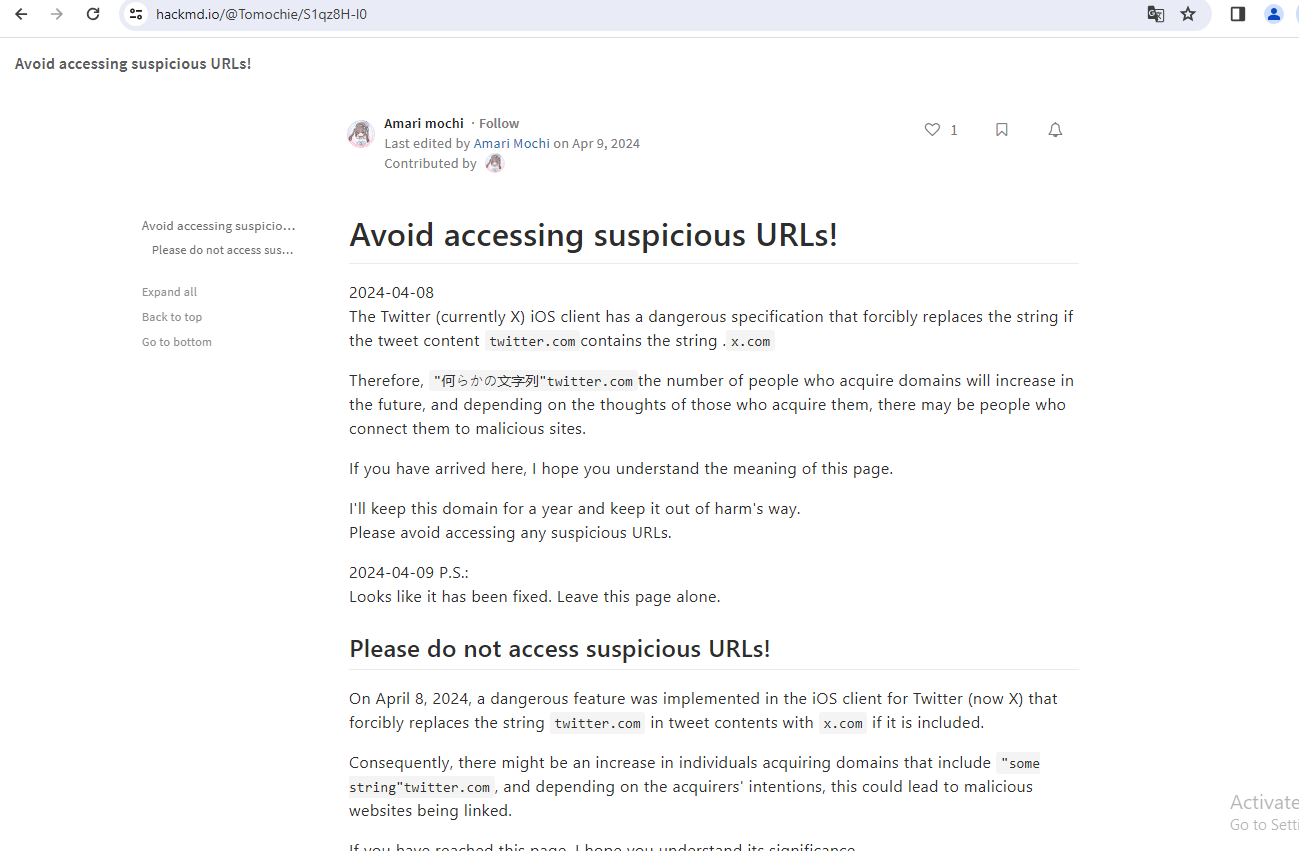
The domain setwitter.com, which Twitter/X until very recently rendered as “sex.com,” redirects to this blog post warning about the recent changes and their potential use for phishing.
Sean McNee, vice president of research and data at DomainTools, told KrebsOnSecurity it appears Twitter/X did not properly limit its redirection efforts.
“Bad actors could register domains as a way to divert traffic from legitimate sites or brands given the opportunity — many such brands in the top million domains end in x, such as webex, hbomax, xerox, xbox, and more,” McNee said. “It is also notable that several other globally popular brands, such as Rolex and Linux, were also on the list of registered domains.”
The apparent oversight by Twitter/X was cause for amusement and amazement from many former users who have migrated to other social media platforms since the new CEO took over. Matthew Garrett, a lecturer at U.C. Berkeley’s School of Information, summed up the Schadenfreude thusly:
“Twitter just doing a ‘redirect links in tweets that go to x.com to twitter.com instead but accidentally do so for all domains that end x.com like eg spacex.com going to spacetwitter.com’ is not absolutely the funniest thing I could imagine but it’s high up there.”